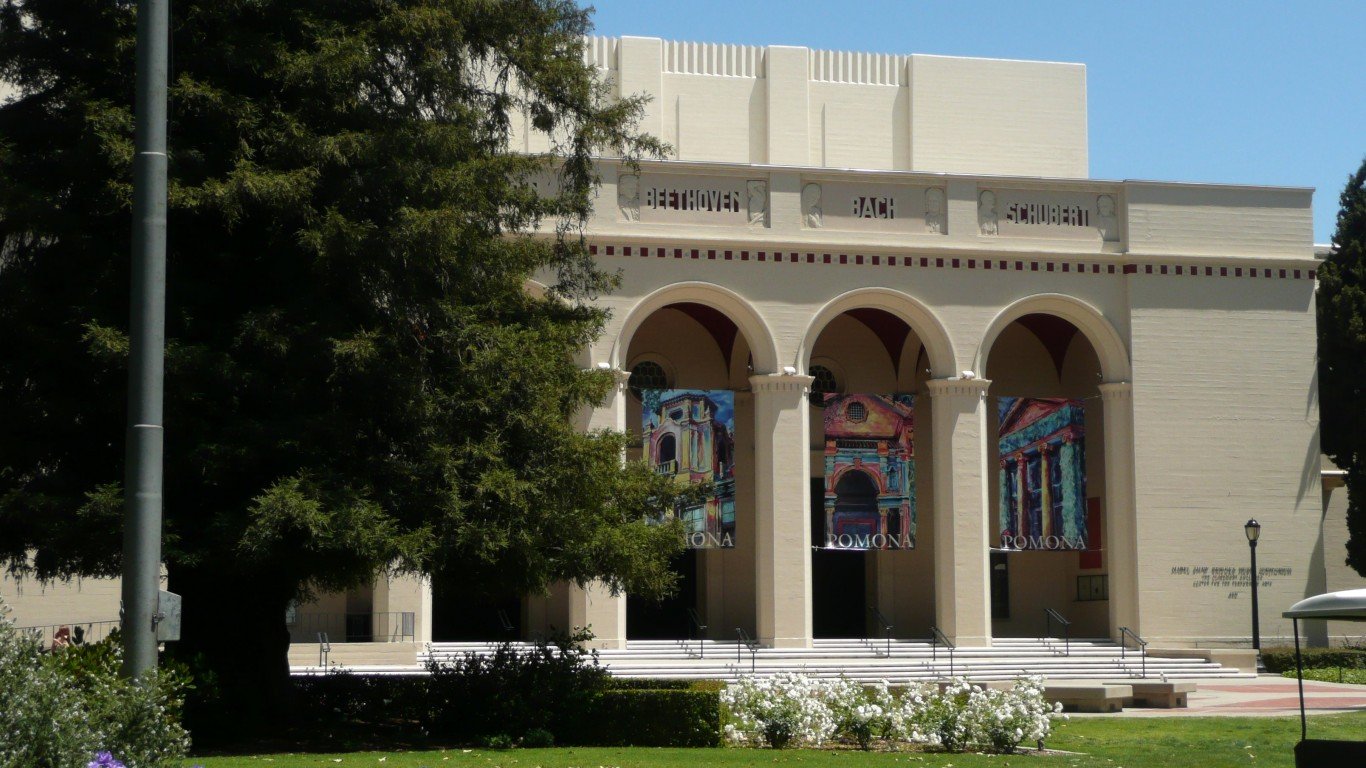

Growing up, many of us were often told that we needed a college education to have a successful career. It often didn’t matter what you were majoring in, simply going to a university was considered the peak of education. While many professions do require an advanced degree, there are other professions where it may not be necessary. Yet, obtaining a post-secondary education is still considered the norm in many places. In 2022, there were an estimated 18.58 million college students in the U.S.
Attending a college or university in recent years has become significantly more challenging. The rising costs of advanced academia have contributed to many questioning if they can afford it or if it’s even worth the cost. According to the Federal Reserve Board, as of 2024, student loan debt in the U.S. has soared to about $1.74 trillion. Even with these additional costs and knowing their potential debt, a college degree is still perceived as key to entering the American middle class, and the competition to get into the nation’s best schools has never been greater.
To identify America’s top colleges and universities in the United States, 24/7 Wall St. reviewed the education and community research platform Niche’s Best Colleges in America ranking and university websites. Niche-ranked schools on a weighted index of multiple measures from the U.S. Department of Education and reviews from students and alumni. The measures used in this ranking are related to academics, value, student life, overall student experience, diversity, safety, and assessments of professors, the school campus, and the surrounding community. A detailed explanation of the methodology is available here.
Those colleges and universities that ranked at the top have some similar characteristics. All but two are East Coast schools. Seven of the top 10 are Ivy League institutions. The top 10 colleges and universities have less than 10% acceptance rates, making them highly selective and enhancing their reputation as the top colleges in the country.
Among the top 10 schools, the University of Pennsylvania is the only one with an undergraduate enrollment of more than 10,000. The smallest student-to-faculty ratios and the highest graduation rates come from these elite universities. (Also see the hardest colleges to get into.)
Earning a degree from any of the prominent universities listed here may improve a graduate’s job prospects. But your future earnings and employment possibilities. Some degrees hold a higher favorability and those who pursue degrees in any STEM field (science, technology, engineering, and math), as well as finance, are more likely to find employment after graduation.
It also gives the potential to earn higher incomes than graduates with degrees in other fields such as education and communications who might struggle to find jobs. (Also see the lowest-paying college majors.)
Here are America’s top colleges and universities.
35. Barnard College (New York, NY)
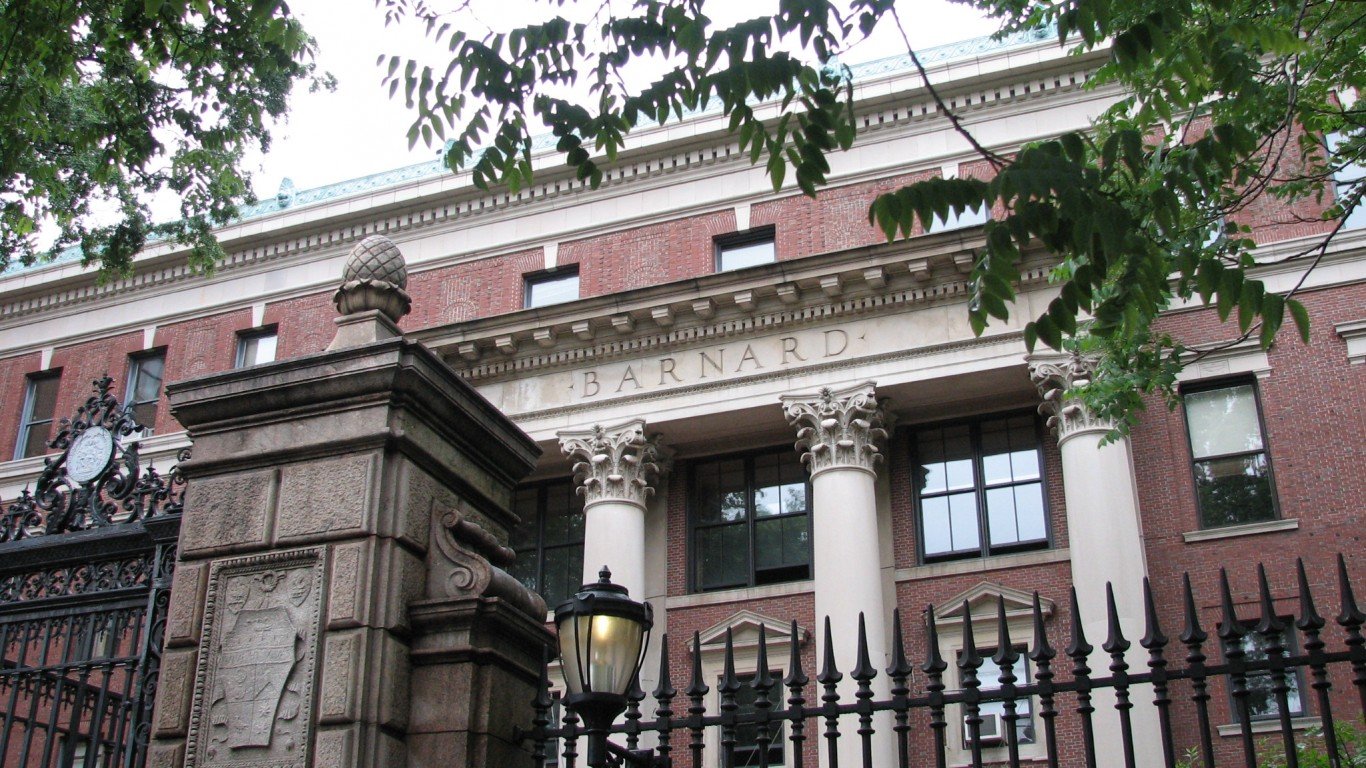
- Acceptance rate: 11.5%
- Student-faculty ratio: 10-to-1
- Graduation rate: 92.8%
Barnard, part of Columbia University, is the top women’s college in America (federal law allows them to not admit men). Founded in 1889, the average annual net price of tuition is $28,366, including financial aid and scholarships. There are 3,043 undergraduates enrolled, of whom 46.2% receive financial aid.
Six years after earning their degree, the median earnings for graduates is $57,900, and the percentage of alumni who are employed two years after graduation is 95.7.
34. Tufts University (Medford, MA)

- Acceptance rate: 11.4%
- Student-faculty ratio: 6-to-1
- Graduation rate: 93.8%
Tufts University was founded in 1852, and its motto, Pax et Lux (Peace and Light) highlights the camaraderie of the faculty and students who work together to impact the world. The average annual net price of tuition is $31,630, including financial aid and scholarships, and the student body is comprised of 6,676 undergraduates (45.7% receive financial aid).
The median earnings of degree holders six years after graduating is $75,800, and the percentage of alumni who are employed two years after graduation is 94.4.
33. Swarthmore College (Swarthmore, PA)
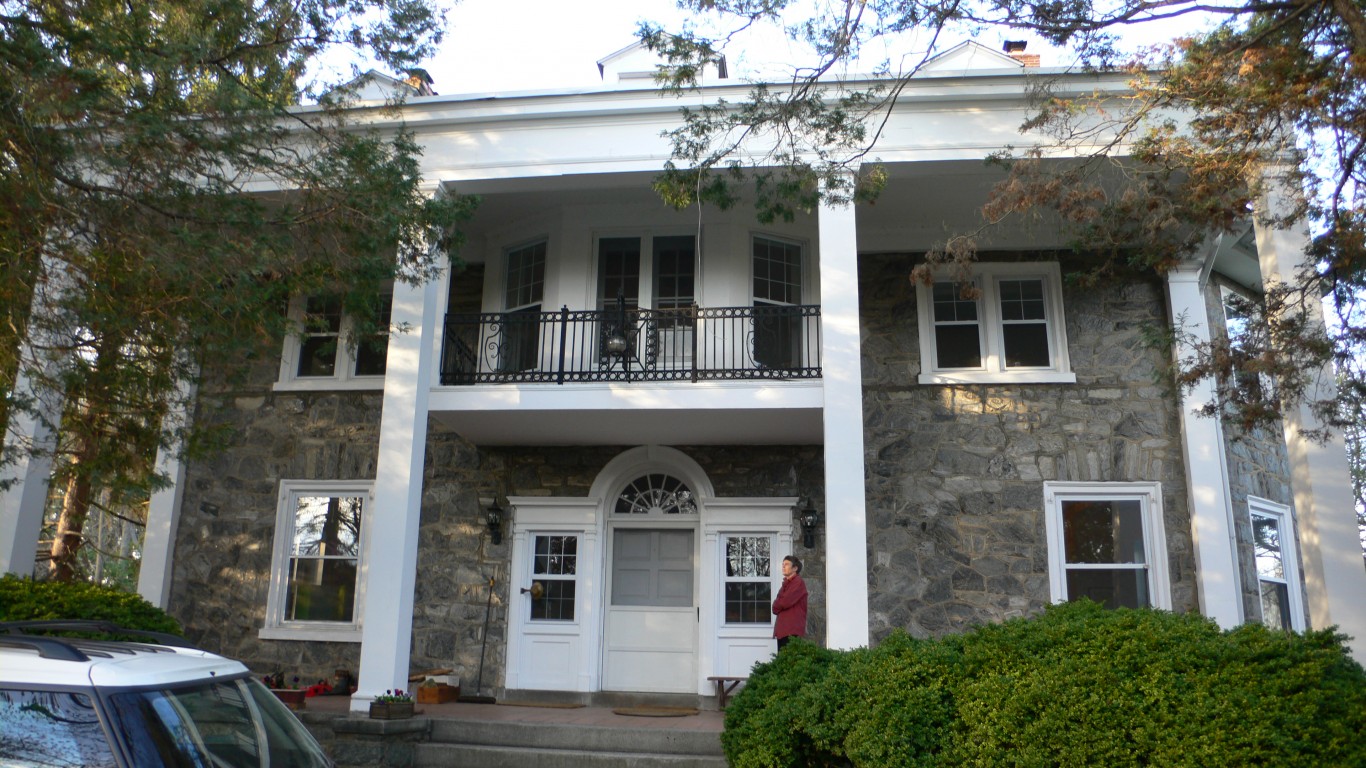
- Acceptance rate: 7.8%
- Student-faculty ratio: 7-to-1
- Graduation rate: 94.1%
This private college was founded in the early 1860s and is not only one of the top diverse campuses in the nation but is also one of the top liberal arts schools. The average annual net price of tuition is $19,733, including financial aid and scholarships. There are 1,651 undergraduates enrolled (78.1% receive financial aid), and the median earnings six years after receiving their degree is $56,700. The percentage of alumni employed two years after graduation is 98.5.
32. Williams College (Williamstown, MA)
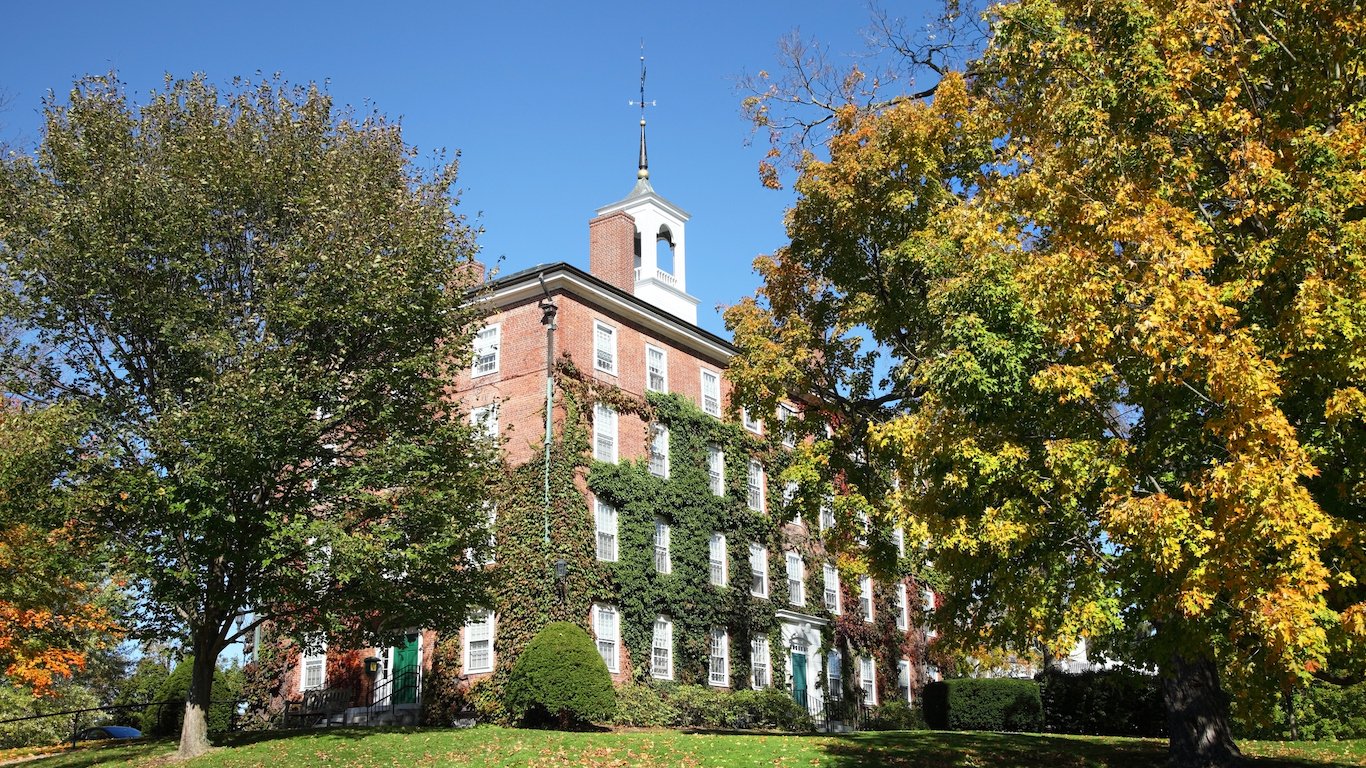
- Acceptance rate: 8.8%
- Student-faculty ratio: 6-to-1
- Graduation rate: 93.8%
One of the top colleges for liberal arts and arts, Williams College was founded in 1793. This private institution has an undergraduate enrollment of 2,174, of which 60.5% receive financial aid. The average net cost of tuition is $14,487, including financial aid and scholarships. The median earnings for graduates six years after they receive their degree is $59,000, and the percentage of alumni that are employed two years after graduation is 92.8
31. Davidson College (Davidson, NC)
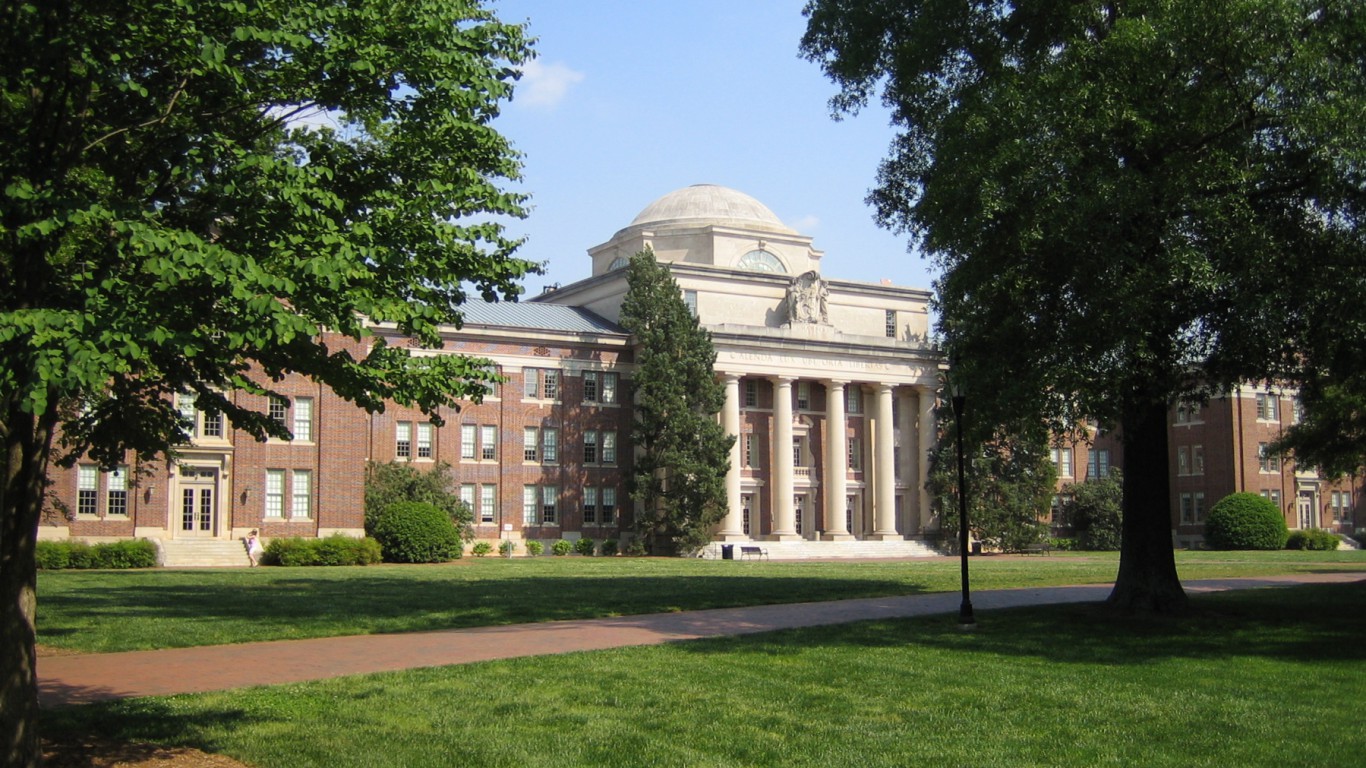
- Acceptance rate: 17.8%
- Student-faculty ratio: 9-to-1
- Graduation rate: 89.6%
Davidson College is home to NCAA athletics and is not only one of the top liberal arts colleges but also the first liberal arts institution to eliminate loans in financial aid packages. The average annual net price is $25,794, including financial aid and scholarships, and has an undergraduate enrollment of 1,973 (69.6% receive financial aid).
Six years after graduation, the median earnings is $58,900. (The percentage of alumni employed two years after receiving their degree was unavailable.)
30. University of Virginia (Charlottesville, VA)
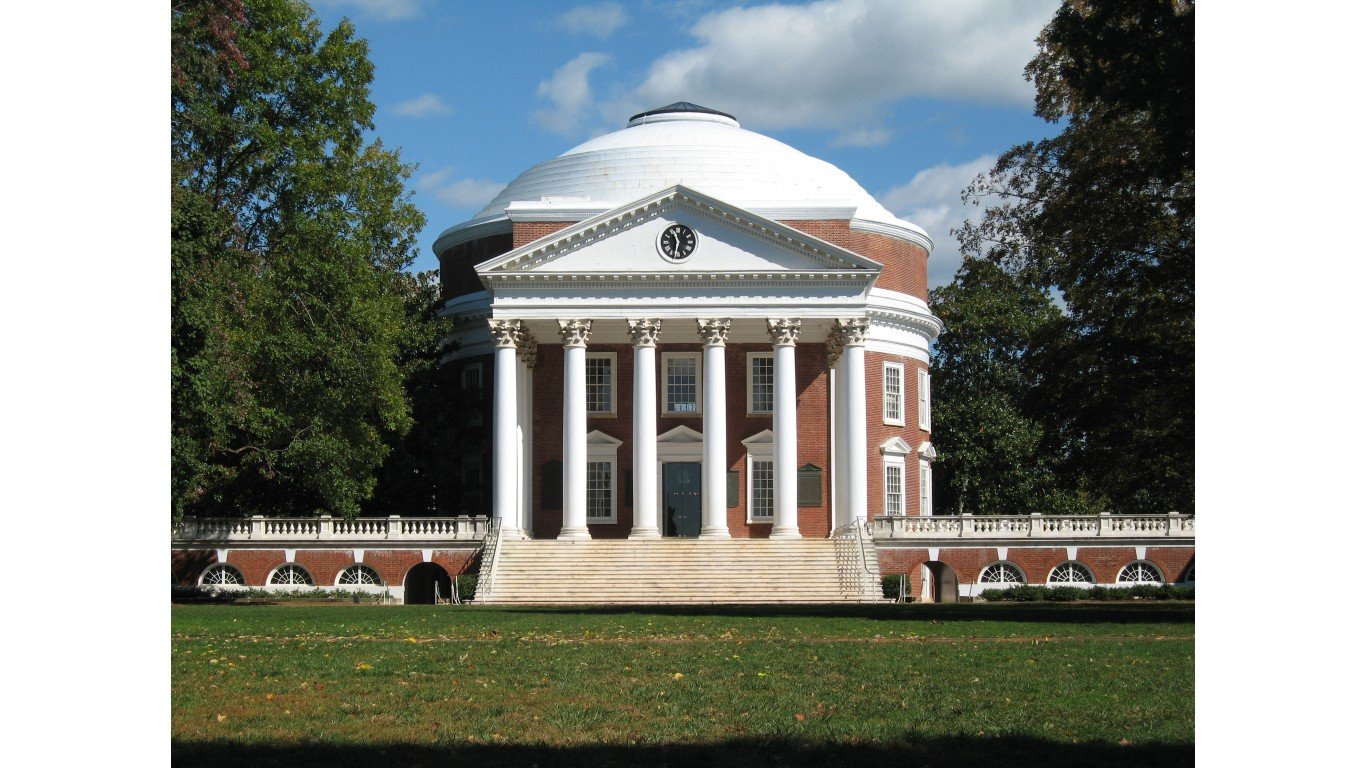
- Acceptance rate: 20.7%
- Student-faculty ratio: 7-to-1
- Graduation rate: 93.7%
One of the top public universities in the country, the University of Virginia was founded in 1819 by Thomas Jefferson. In addition to their top academics, the school also offers NCAA athletics. The average annual net price is $20,401, with financial aid and scholarships, and the undergraduate enrollment is 17,294, of which 62.5% receive financial aid.
Median earnings six years after graduation are $61,200, with the percentage of alumni employed two years after graduation standing at 94.
29. Bowdoin College (Brunswick, ME)
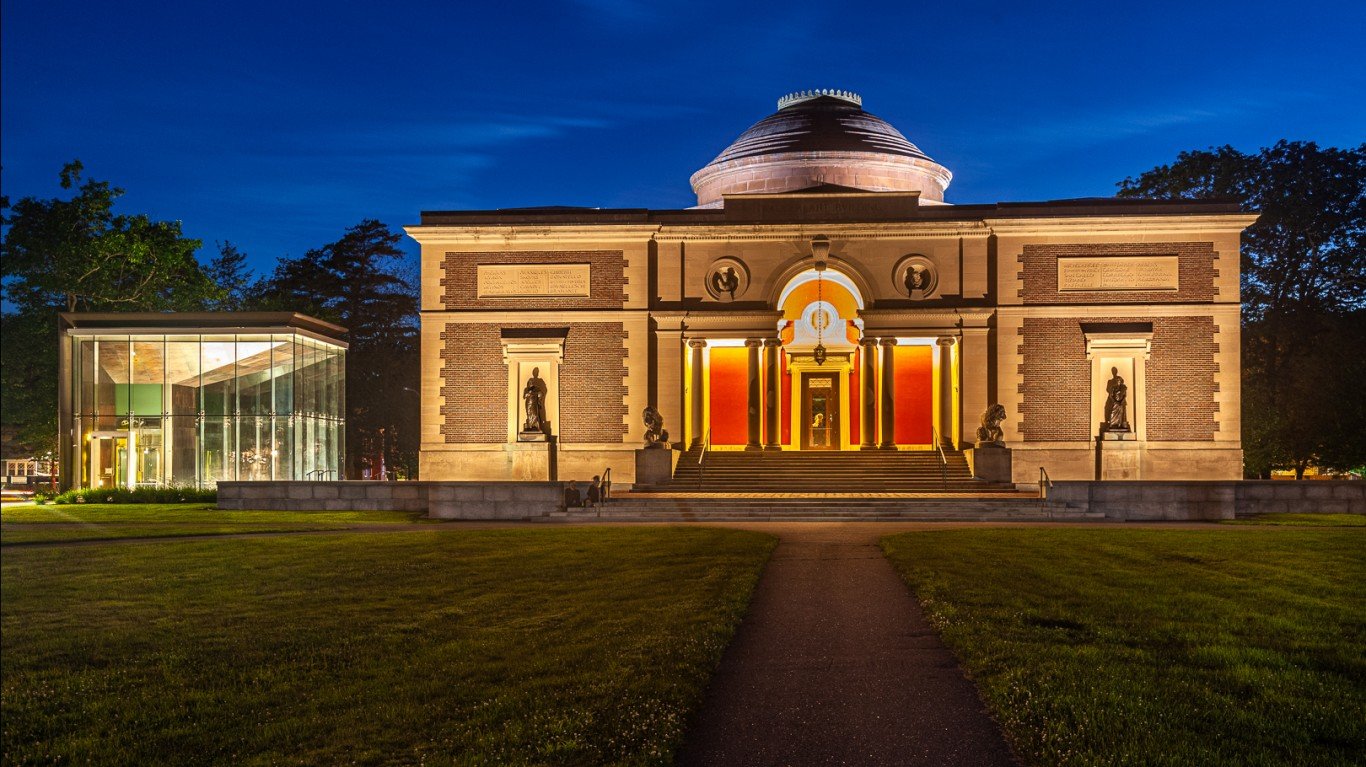
- Acceptance rate: 8.8%
- Student-faculty ratio: 8-to-1
- Graduation rate: 93.8%
Founded in 1794, Bowdoin College is one of the top liberal arts and small colleges in America. This coastal college has an average annual net price of $26,727, including financial aid and scholarships. Undergraduate enrollment is 1,915, of which 61.6% receive financial aid. Median earnings six years after graduation is $65,500, and the percentage of alumni employed two years after graduation is 96.4.
28. Georgia Institute of Technology (Atlanta, GA)

- Acceptance rate: 16.0%
- Student-faculty ratio: 13-to-1
- Graduation rate: 91.9%
One of the top public universities, and also one of the best for engineering, the Georgia Institute of Technology, also called Georgia Tech, was founded in 1885 as the Georgia School of Technology, changing its name in 1948. The average annual net price is $17,360, including financial aid and scholarships. Undergraduate enrollment is 17,360 (72.1% receive financial aid).
The median earnings six years after graduation is $79,100, and the percentage of alumni employed after two years is 95.9.
27. University of Notre Dame (Notre Dame, IN)
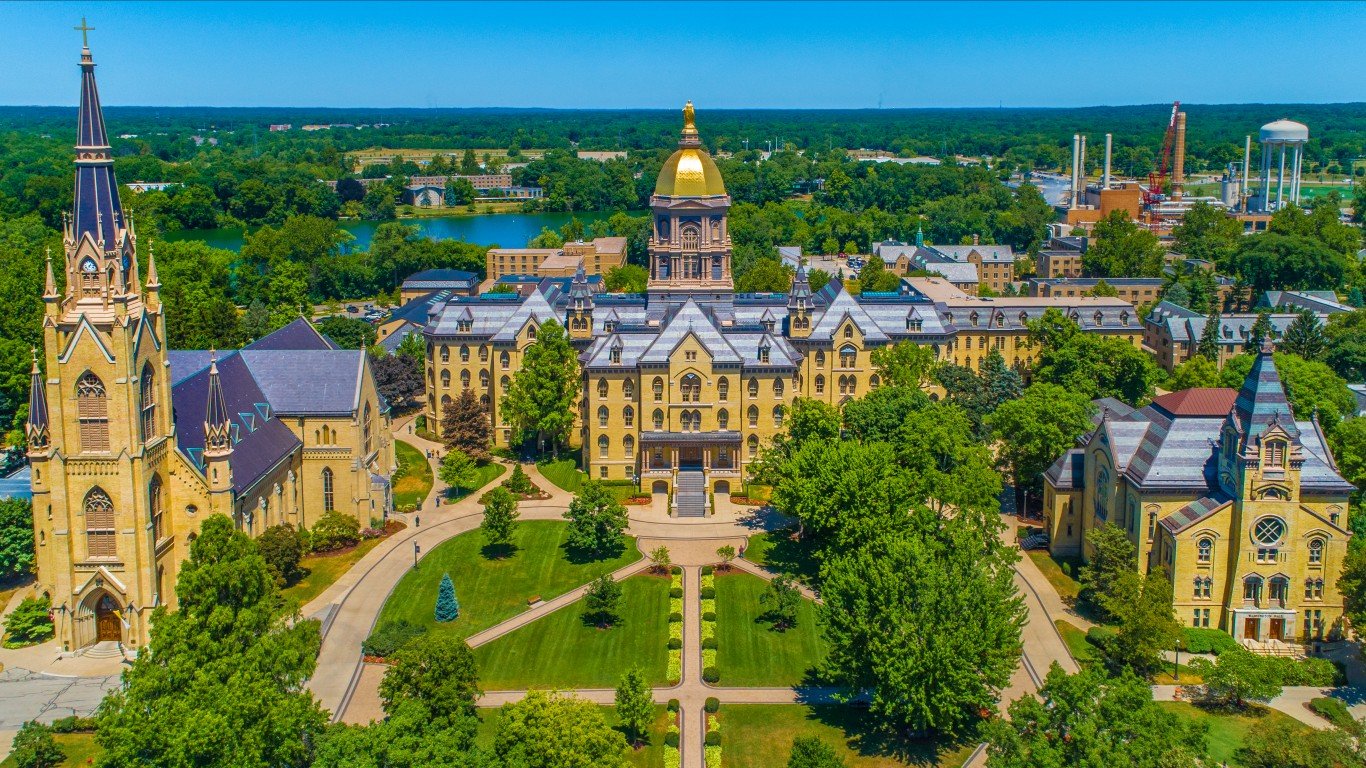
- Acceptance rate: 15.1%
- Student-faculty ratio: 7-to-1
- Graduation rate: 95.9%
Founded in 1842, this private research university is one of the top Catholic universities in the country. Among other degrees, the University of Notre Dame is one of the top institutions for accounting and finance. The average annual net price is $30, 510, including financial aid and scholarships, with an undergraduate enrollment of 8,973 (68.2% receive financial aid).
The median earnings six years after graduation is $78,400, and the percentage of alumni employed two years after graduation is 95.1.
26. University of Southern California (Los Angeles, CA)
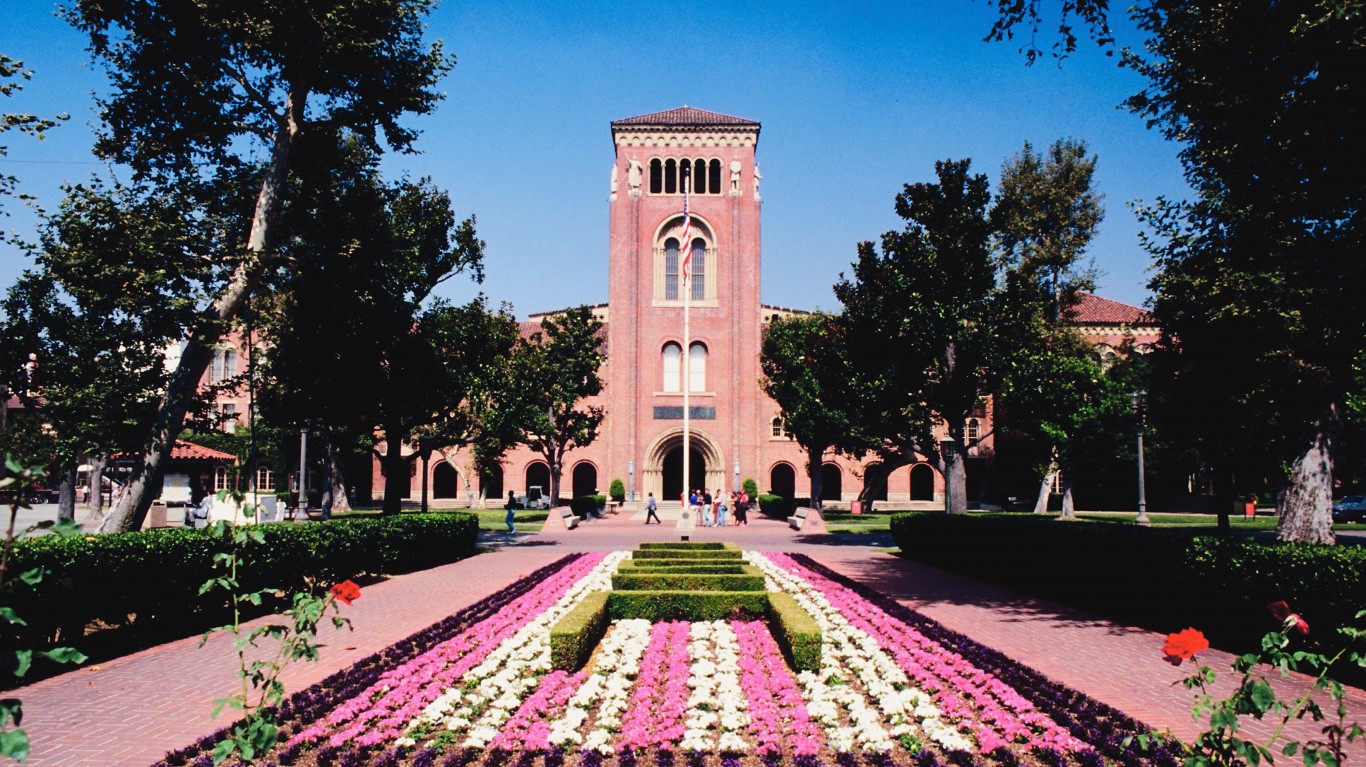
- Acceptance rate: 12.5%
- Student-faculty ratio: 7-to-1
- Graduation rate: 92.0%
This NCAA, Pac-12 school was founded in 1880 and has an undergraduate enrollment of 20,790, of which 76.1 receive financial aid. USC is one of the top universities in the nation for communications as well as the best student life on campus. The average annual net price is $26,021, with financial aid and scholarships.
The median earnings for graduates six years after completing their degree is $74,000, and the percentage of alumni employed two years after graduation is 92.4.
25. Claremont McKenna College (Claremont, CA)

- Acceptance rate: 11.2%
- Student-faculty ratio: 8-to-1
- Graduation rate: 92.7%
One of the top liberal arts colleges in the country, Claremont McKenna College was founded in 1946, although it was originally a college for men (women were admitted in 1976). The average annual net price for the 1,416 undergraduates (66% receive financial aid) is $21,663, including financial aid and scholarships.
The median earnings of graduates six years after receiving their degree is $72,900, and the percentage of alumni employed two years after graduation is 96.2.
24. Johns Hopkins University (Baltimore, MD)
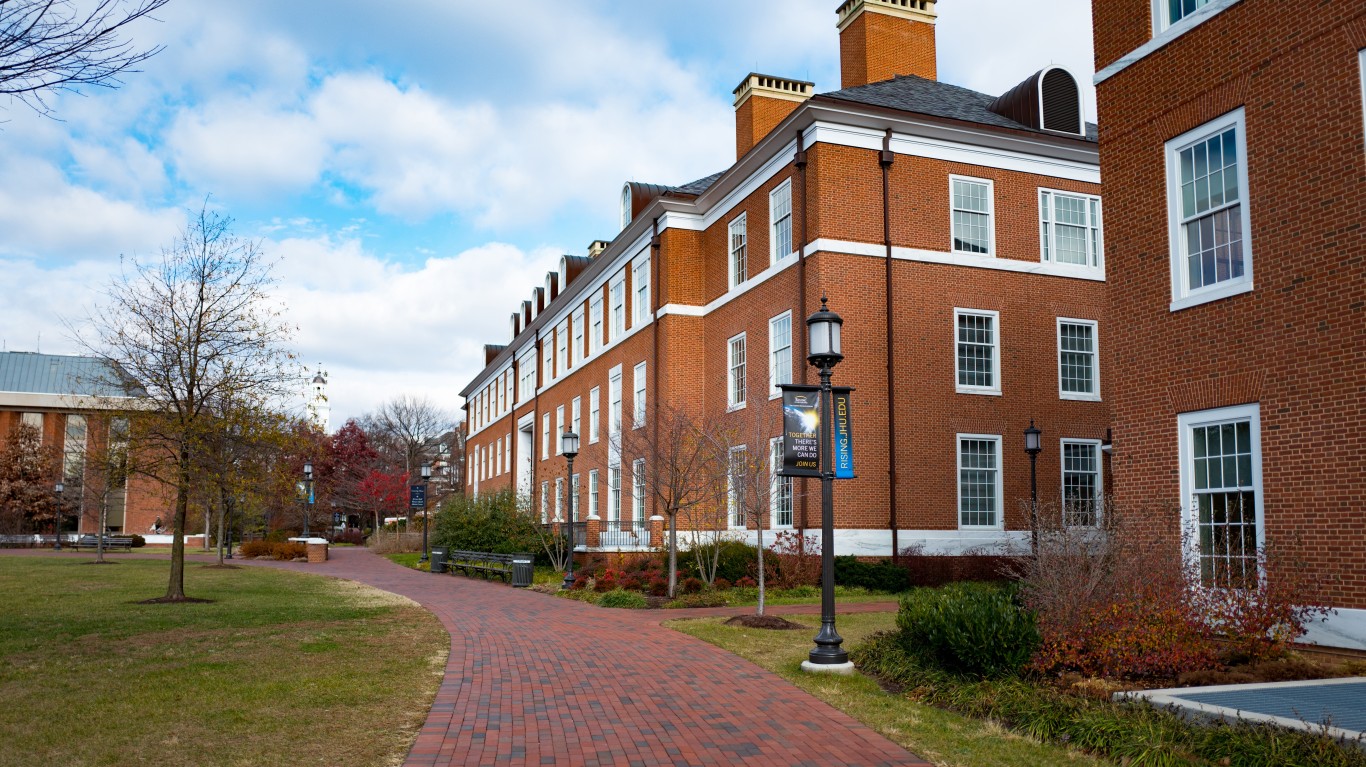
- Acceptance rate: 7.5%
- Student-faculty ratio: 2-to-1
- Graduation rate: 94.6%
Opened in 1876, John Hopkins University not only has one of the best colleges for a degree in public health but also has one of the best financial aid programs in the nation, with 71.4 % of the 6,132 enrolled undergraduates receiving. The average annual net price is $20,680, with financial aid and scholarships, and median earnings six years after graduation is $73,200. The percentage of alumni employed two years after graduation is 95.3.
23. University of Chicago (Chicago, IL)
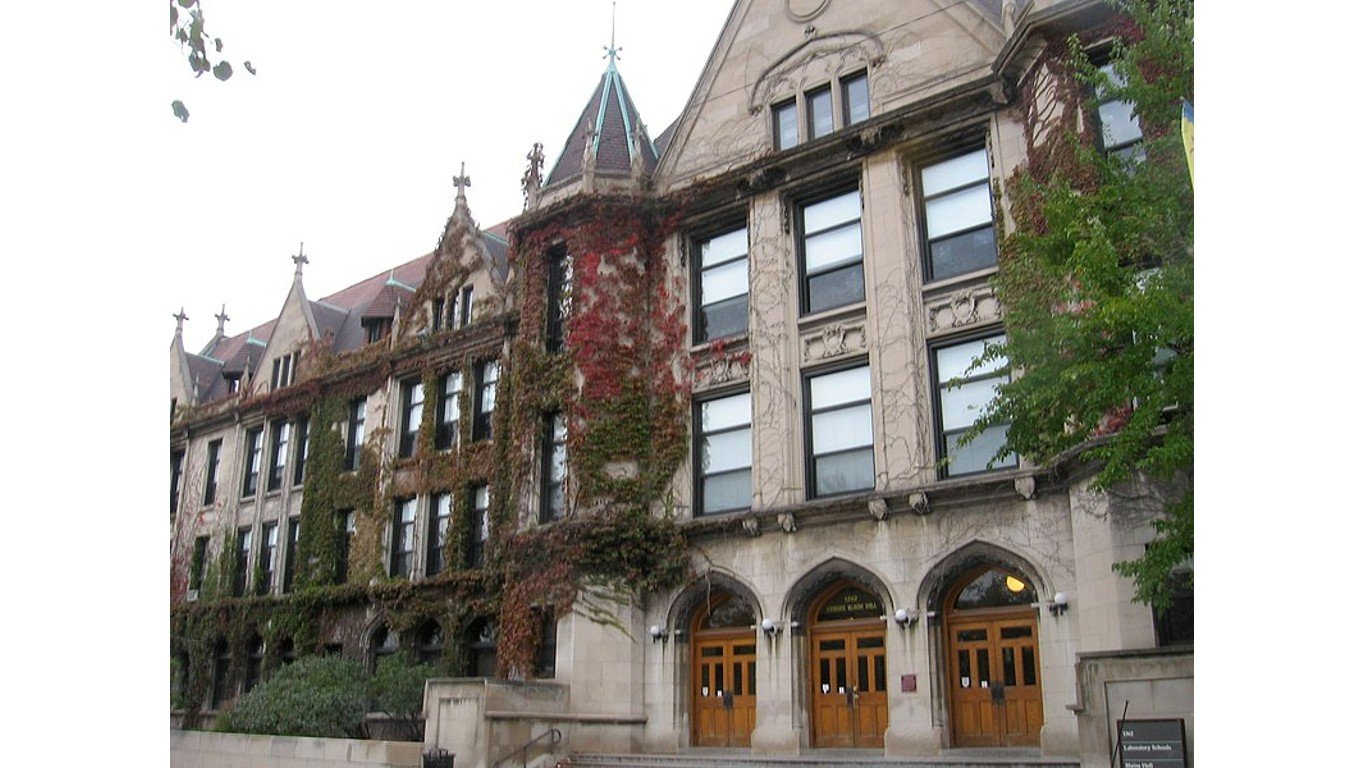
- Acceptance rate: 6.5%
- Student-faculty ratio: 3-to-1
- Graduation rate: 95.9%
This liberal arts college, founded in 1890, has an undergraduate enrollment of 7,636 (58% receive financial aid). The University of Chicago is one of the top colleges for degrees in public policy, philosophy, and religious studies. With financial aid and scholarships, the average annual net price is $33,727. The median earnings six years after graduation is $68,100; the percentage of alumni employed two years after graduation is 93.2.
22. Cornell University (Ithaca, NY)

- Acceptance rate: 8.7%
- Student-faculty ratio: 8-to-1
- Graduation rate: 94.1%
This NCAA, Ivy League university was founded in 1865 and has 15,735 undergraduates (57.7% receive financial aid). It is the top university for degrees in information technology, architecture, and agricultural sciences. The average annual net price is $24,262 (with financial aid and scholarships). The median earnings six years after graduation is $77,200, and the percentage of alumni employed two years after graduation is 91.4.
21. University of Michigan (Ann Arbor, MI)
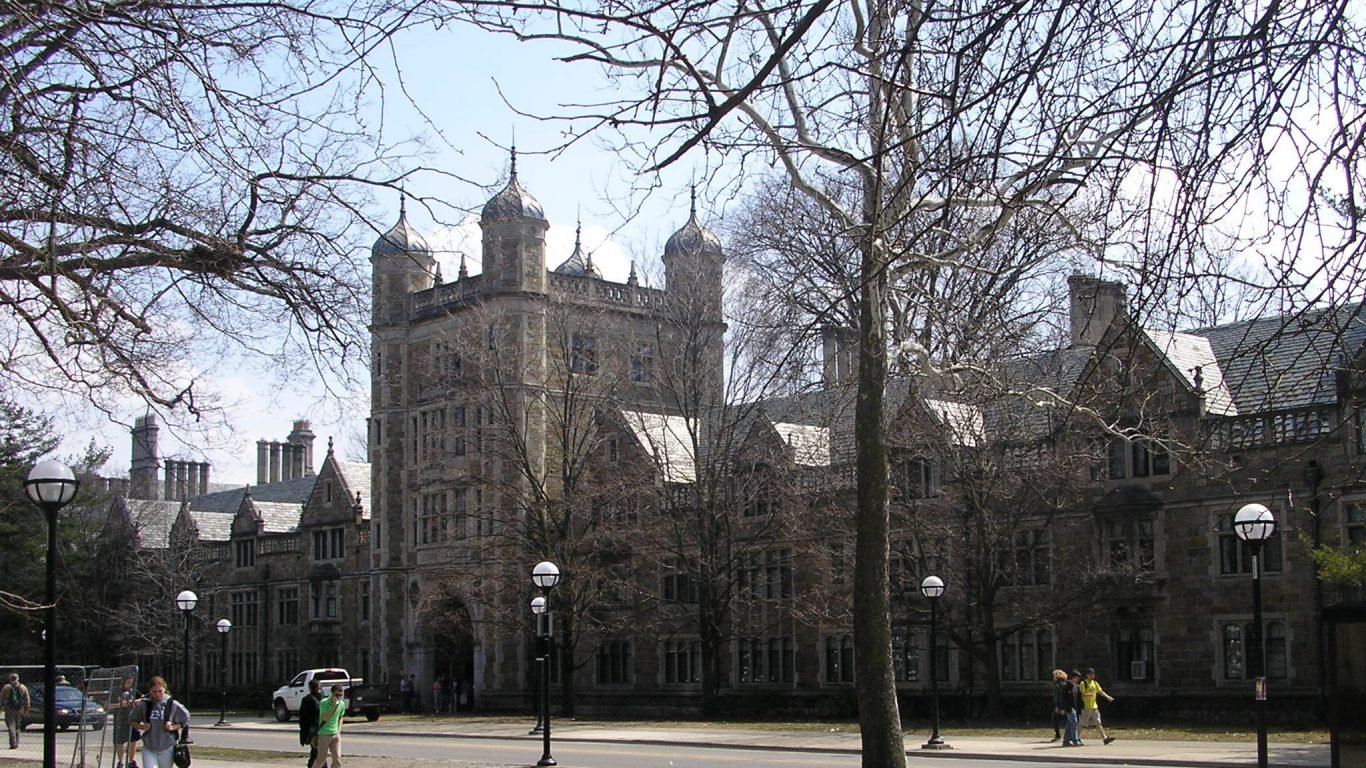
- Acceptance rate: 20.2%
- Student-faculty ratio: 4-to-1
- Graduation rate: 93.7%
If you wish to obtain a degree in education, or kinesiology and physical therapy, this top-rated public institution may be your choice. Founded in 1817, the University of Michigan at Ann Arbor has 32,282 undergraduates (70.2 receive financial aid). The median earnings of graduates six years after earning their degree is $63,400. The percentage of alumni employed two years after graduation is 94.8.
20. Carnegie Mellon University (Pittsburgh, PA)
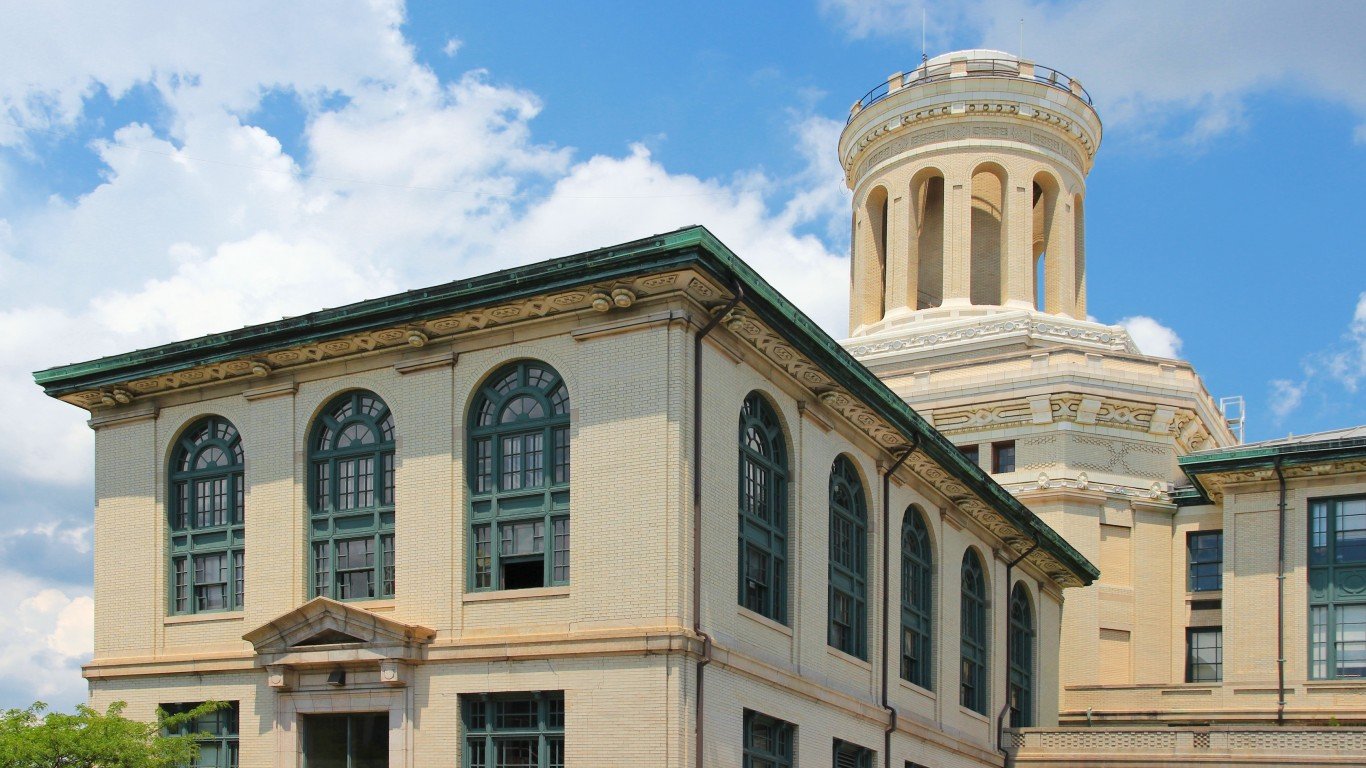
- Acceptance rate: 13.5%
- Student-faculty ratio: 5-to-1
- Graduation rate: 92.8%
Carnegie Mellon is one of the top universities in the country for degrees in design, computer sciences, and information technology. Founded in 1900 by Andrew Carnegie as the Carnegie Technical School, it later became the Carnegie Institute of Technology and began granting four-year degrees. In 1967 it merged with Mellon University to become what it is today.
The university is home to 6,932 undergraduates (58.9% receive financial aid), and the median earnings six years after graduation is $83,600. The percentage of alumni employed two years after graduation is 93.4.
19. University of California – Los Angeles (Los Angeles, CA)
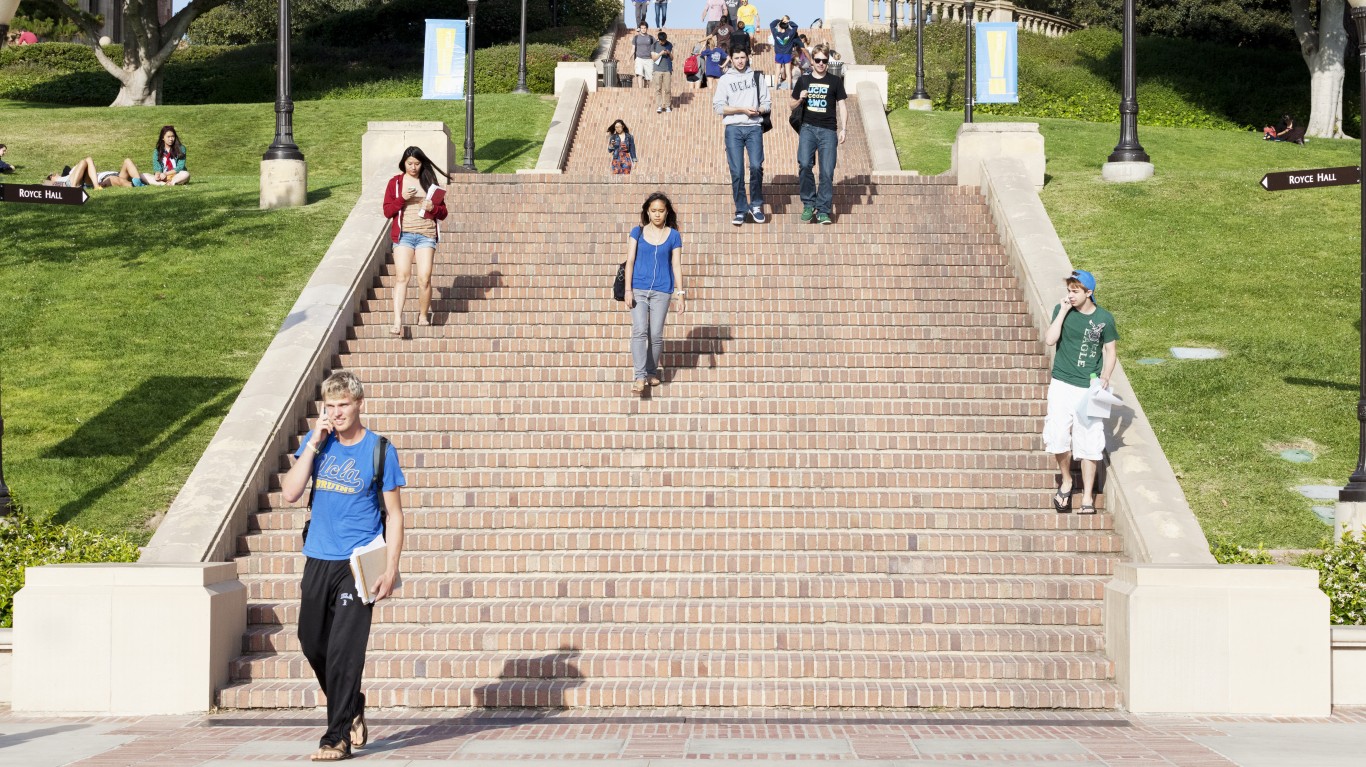
- Acceptance rate: 10.8%
- Student-faculty ratio: 7-to-1
- Graduation rate: 92.1%
The University of California, Los Angeles, or UCLA, is considered the top college campus in the country, as well as the number one choice for student life. Founded in 1919, the university has an undergraduate enrollment of 32,122 (56.3% receive financial aid), and the median earnings six years after graduation is $60,700. The percentage of alumni who are employed two years after graduation is 91.1.
18. Pomona College (Claremont, CA)
- Acceptance rate: 6.6%
- Student-faculty ratio: 7-to-1
- Graduation rate: 93.0%
Established in 1887, Pomona College is one of the most diverse campuses in the nation. It has an undergraduate enrollment of 1,777 (58.9% receive financial aid) and is considered one of the world’s leading liberal arts colleges. The median earnings six years after graduation is $58,100 and the percentage of alumni employed two years after graduation is 96.8.
17. California Institute of Technology (Pasadena, CA)
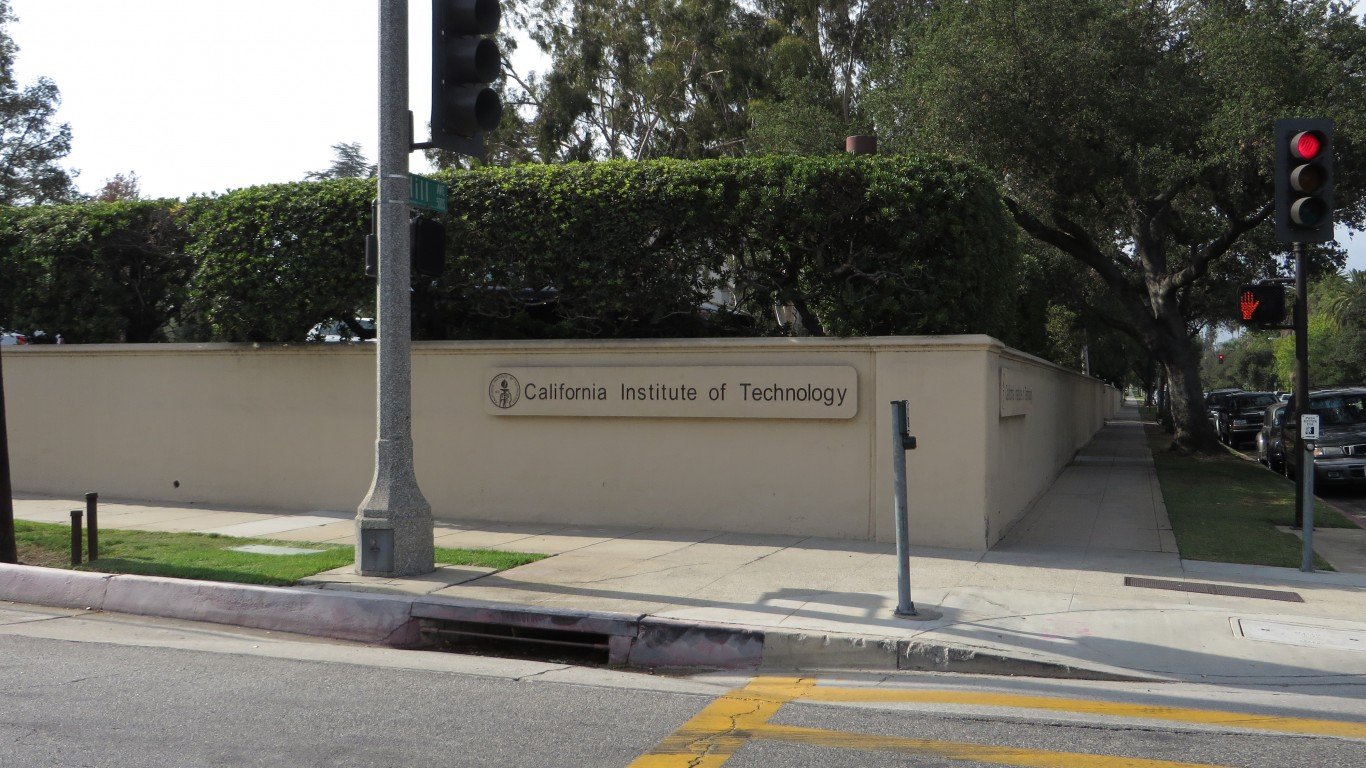
- Acceptance rate: 3.9%
- Student-faculty ratio: 3-to-1
- Graduation rate: 92.9%
Known throughout the world for its science and engineering programs, the California Institute of Technology, or Caltech, was founded in 1891 as Throop University, later changing to Caltech in 1920. This small school offers 982 undergraduates (67.1% receive financial aid) many opportunities, one of which is working with NASA’s Jet Propulsion Laboratory.
The median earnings six years after graduation is $85,900. (No data was available on alumni employed two years after receiving their degrees.)
16. Washington University (St. Louis, MO)
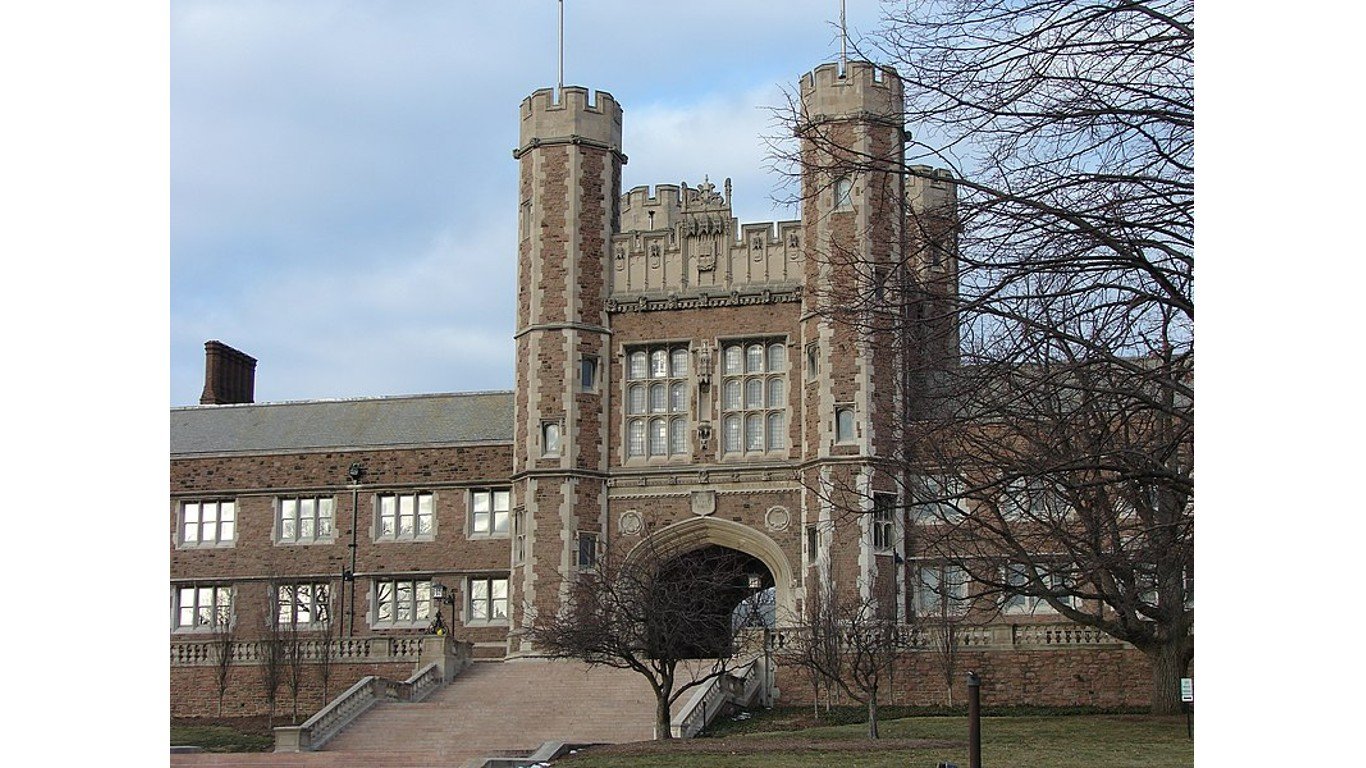
- Acceptance rate: 13.0%
- Student-faculty ratio: 4-to-1
- Graduation rate: 93.1%
Founded in 1853, Washington University’s motto is Per Veritatem Vis (Strength Through Truth), and is rated the top school for a degree in design. One of the top college campuses in the country, it is home to 8,132 undergraduates (52.6% receive financial aid). The average annual net price, with financial aid and scholarships, is $28,298. Median earnings six years after graduation is $70,100, while the percentage of alumni employed two years after receiving their degree is 96.8%.
15. Northwestern University (Evanston, IL)
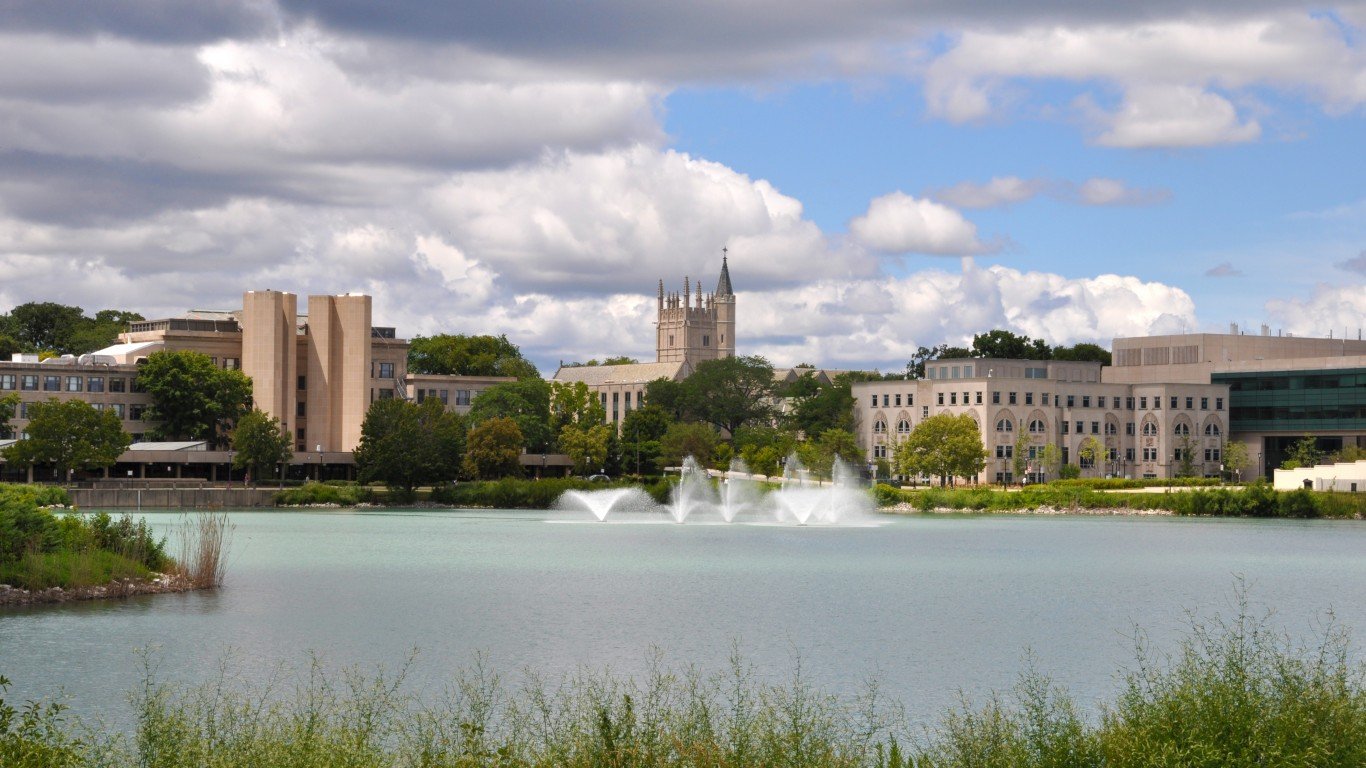
- Acceptance rate: 7.0%
- Student-faculty ratio: 3-to-1
- Graduation rate: 95.2%
Northwestern University is one of only three top-10 universities in the United States that are ranked in the top 20 in each of the five graduate education categories and is renowned for its programs in journalism and communications (ranked number two in the nation), engineering and technology, business and economics, and much more.
Founded in 1851, the university welcomes 8,847 undergraduate students, of which 65.7% received financial aid. The median earnings of alumni six years after graduation is $69,000, and the percentage of those employed two years after receiving their degrees is 94.5.
14. Vanderbilt University (Nashville, TN)
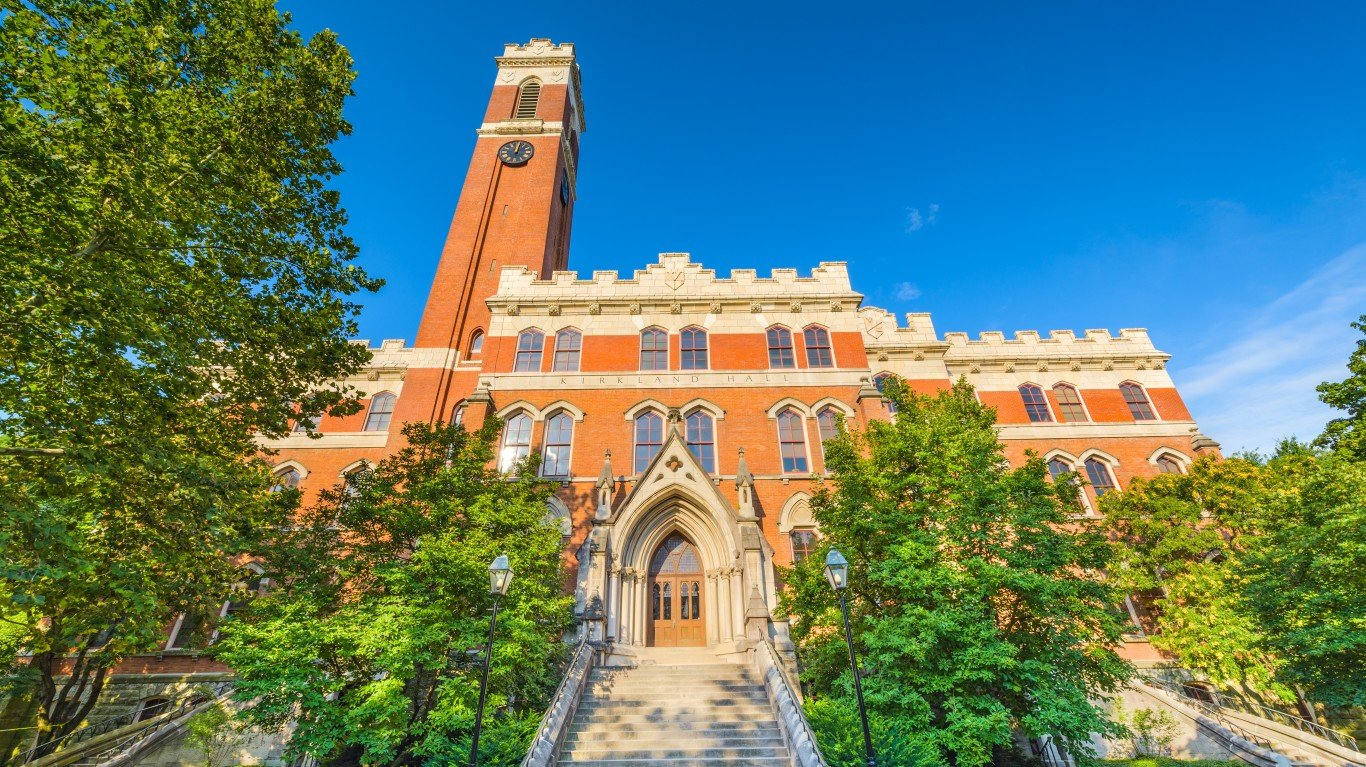
- Acceptance rate: 7.1%
- Student-faculty ratio: 5-to-1
- Graduation rate: 93.4%
This NCAA university was founded in 1873 and consists of ten schools, four of which are undergraduate. It is considered the top school for a degree in education. Vanderbilt has a nationally famed financial aid program, Opportunity Vanderbilt, that assists 69.9% of the 7,111 students who are earning their bachelor’s degree.
The alumni employment rate two years after graduating is 95.5% and the median earnings six years after degree completion is $69,000.
13. Duke University (Durham, NC)
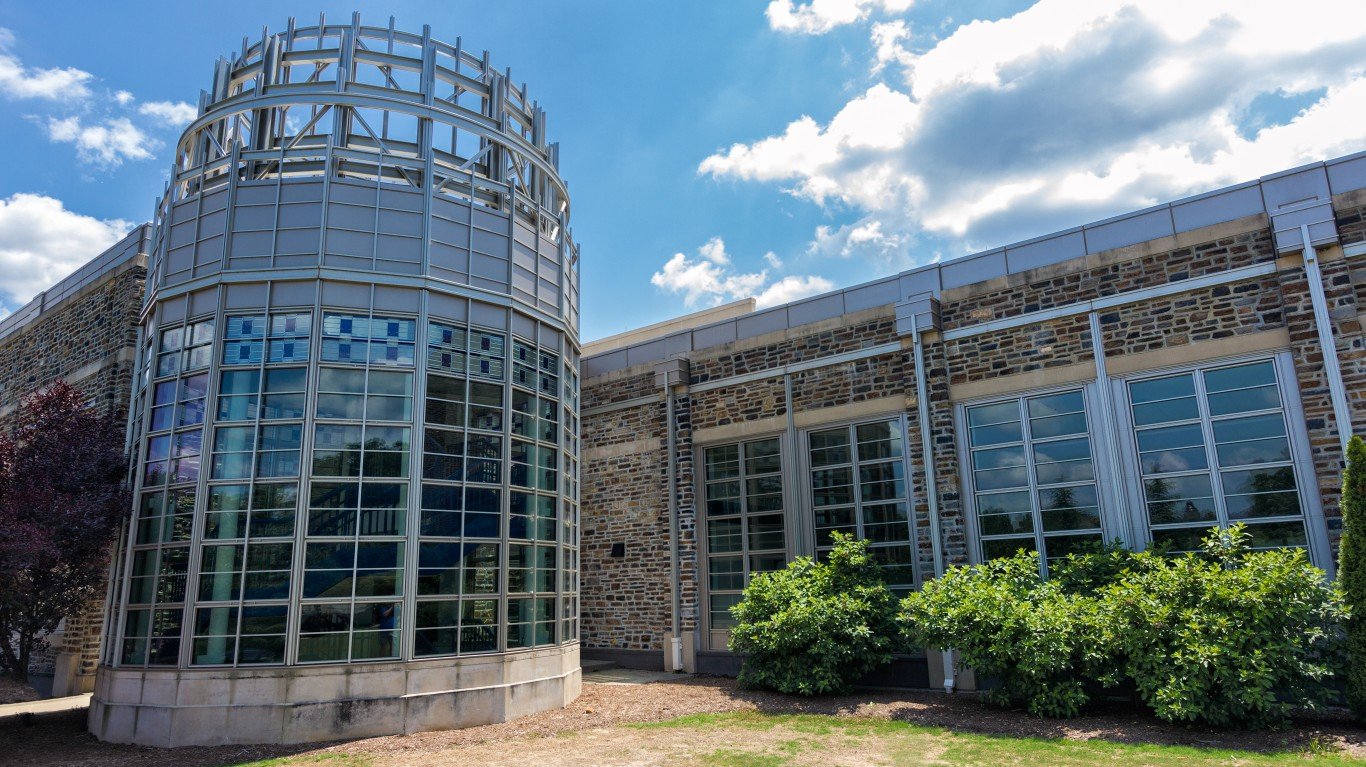
- Acceptance rate: 5.9%
- Student-faculty ratio: 2-to-1
- Graduation rate: 95.9%
There are more than 50 majors for the 6,640 undergraduates to choose from at Duke University, which ranks as number one in public policy. There are 60.9% of students who receive financial aid, and coupled with scholarships, the average annual net price is $27.297. The median earnings for graduates six years after receiving their degree is $84,400, and those alumni employed two years after graduation is 94.1%.
12. Georgetown University (Washington, DC)
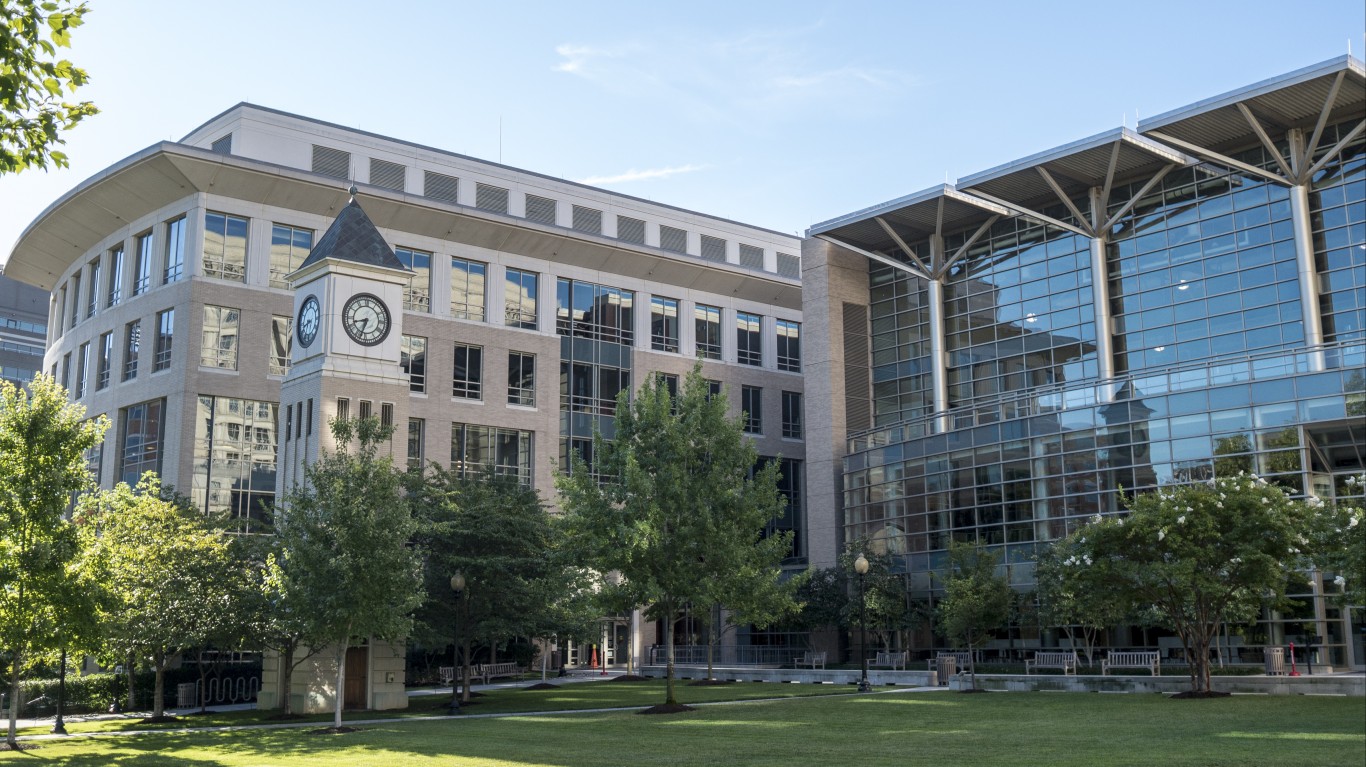
- Acceptance rate: 12.0%
- Student-faculty ratio: 4-to-1
- Graduation rate: 95.2%
This Catholic university features a LEED Gold-certified campus that offers more than 95,000 square feet of work, lounge, and meeting spaces for its 7,598 undergraduates, (53.1% receive financial aid) to enjoy. Georgetown University has an average annual net price of $23,049, including financial aid and scholarships.
Graduates have median earnings six years after receiving their degrees of $93,500, and alumni employed two years after graduation are 94.4%.
11. Harvey Mudd College (Claremont, CA)
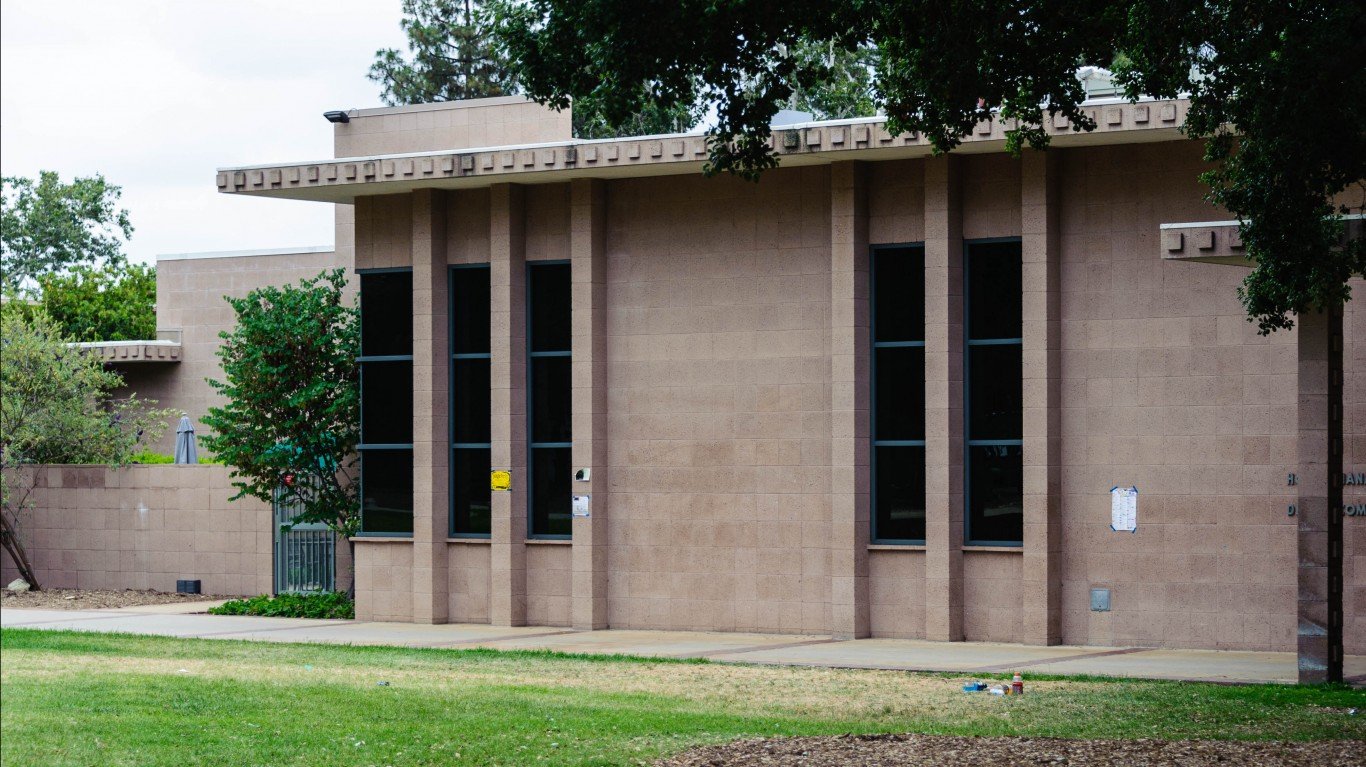
- Acceptance rate: 10.0%
- Student-faculty ratio: 9-to-1
- Graduation rate: 94.4%
- Avg. annual net price: $33,838 (with financial aid and scholarships)
- Undergraduate enrollment: 905 (70.0% receiving financial aid)
- Median earnings six years after graduation: $88,800
- Alumni employed two years after graduation: 98.4%
One of the top engineering, science, and mathematics colleges in America, Harvey Mudd has an undergraduate enrollment of 905, of whom 70% receive financial aid. The average annual net tuition cost is $33,838, which includes financial aid and scholarships. The median earnings for graduates after six years is $88,800, while two years after graduation, 98.4% of alumni are employed.
10. Brown University (Providence, RI)
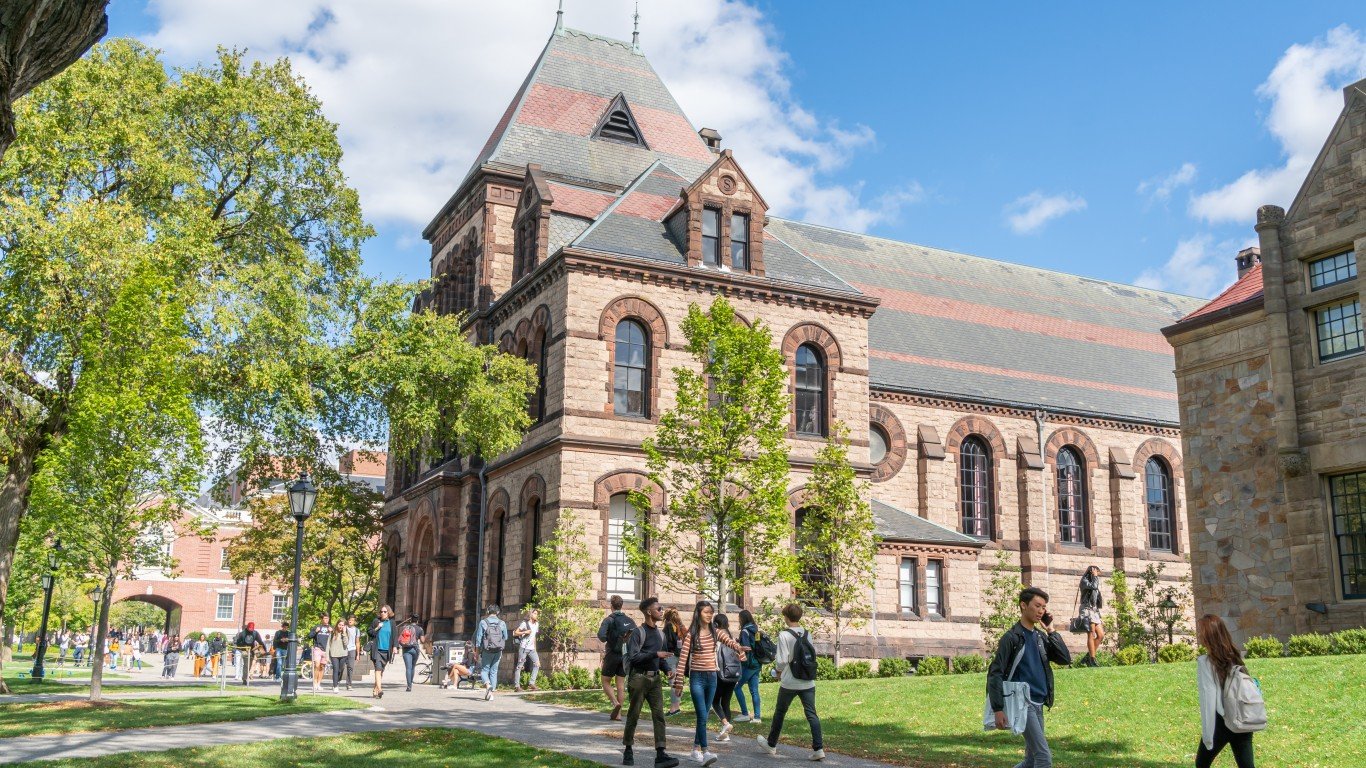
- Acceptance rate: 5.5%
- Student-faculty ratio: 7-to-1
- Graduation rate: 95.8%
Known for its unique open curriculum that allows its 7,349 undergraduates, of whom 55.1% receive financial aid, to develop a personalized course of study, Brown University has an average annual net price of $25,028, with financial aid and scholarships. The median earnings of graduates six years after earning their degrees is $67,500. Alumni employed two years after graduation is 93.5%.
9. Rice University (Houston, TX)
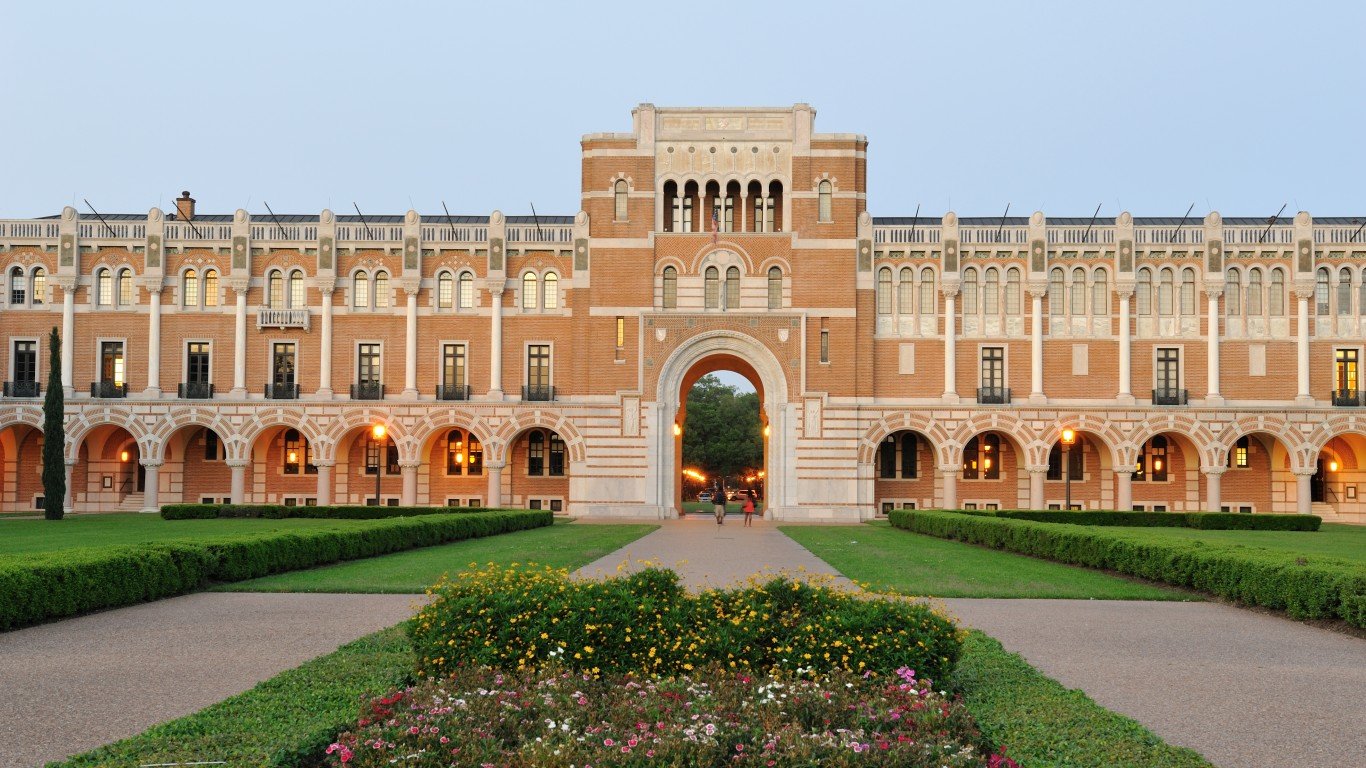
- Acceptance rate: 9.5%
- Student-faculty ratio: 5-to-1
- Graduation rate: 92.3%
Rice University offers more than 50 undergraduate majors to the 4,240 undergraduates enrolled. The percentage of students who receive financial aid is 69.8. Although ranking ninth overall, it comes in first in sports management, kinesiology, and physical therapy. With financial aid and scholarships, the average annual net price comes to $18,521.
The median earnings six years after graduation is $65,400, while alumni employed two years after graduation is 95.4%.
8. Dartmouth College (Hanover, NH)
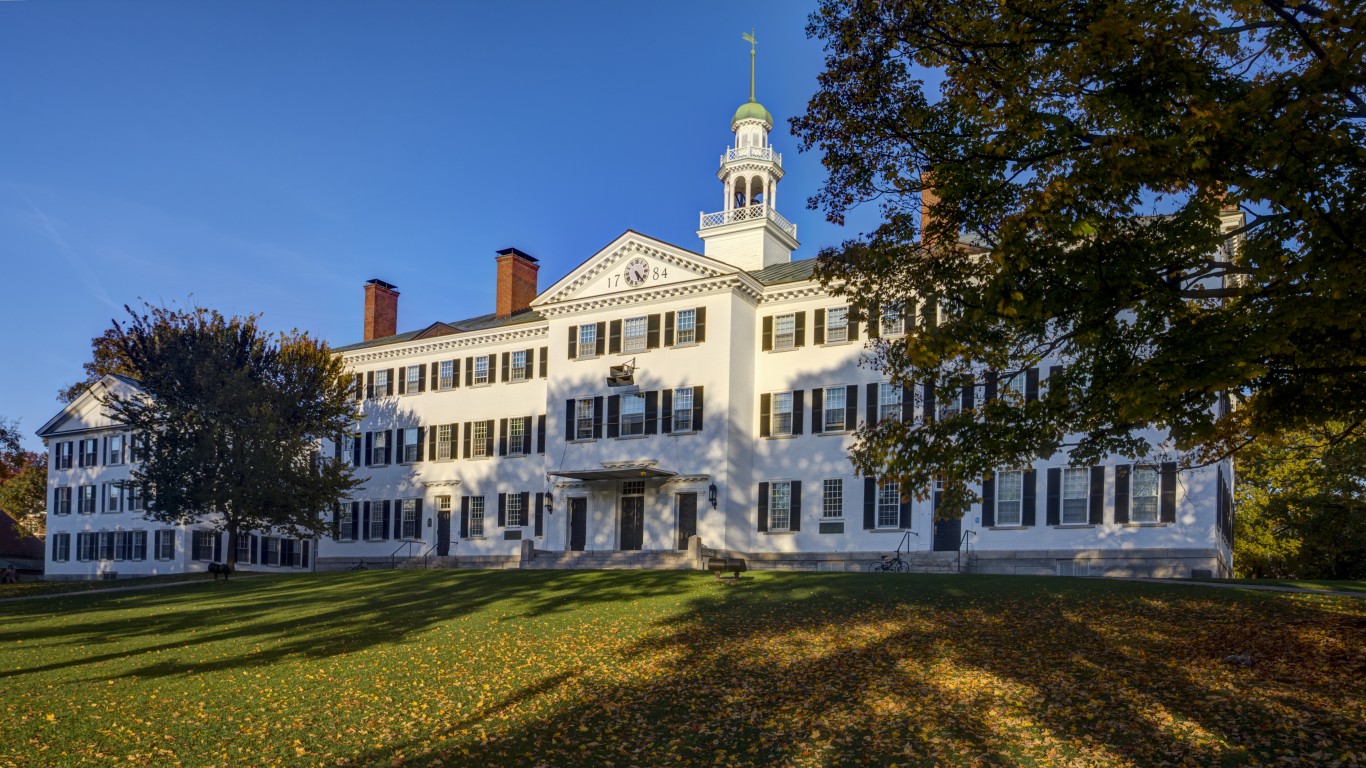
- Acceptance rate: 6.2%
- Student-faculty ratio: 6-to-1
- Graduation rate: 93.6%
This Ivy League private university has an undergraduate enrollment of around 4,555 students who receive 59.7% financial aid. Founded in 1769, there are more than 40 academic programs and departments to choose from, and the average annual net price, including financial aid and scholarships, is $24,078. The median earnings six years after graduation is $75,500, and the percentage of alumni who are employed two years after receiving their degrees is 96.2.
7. University of Pennsylvania (Philadelphia, PA)
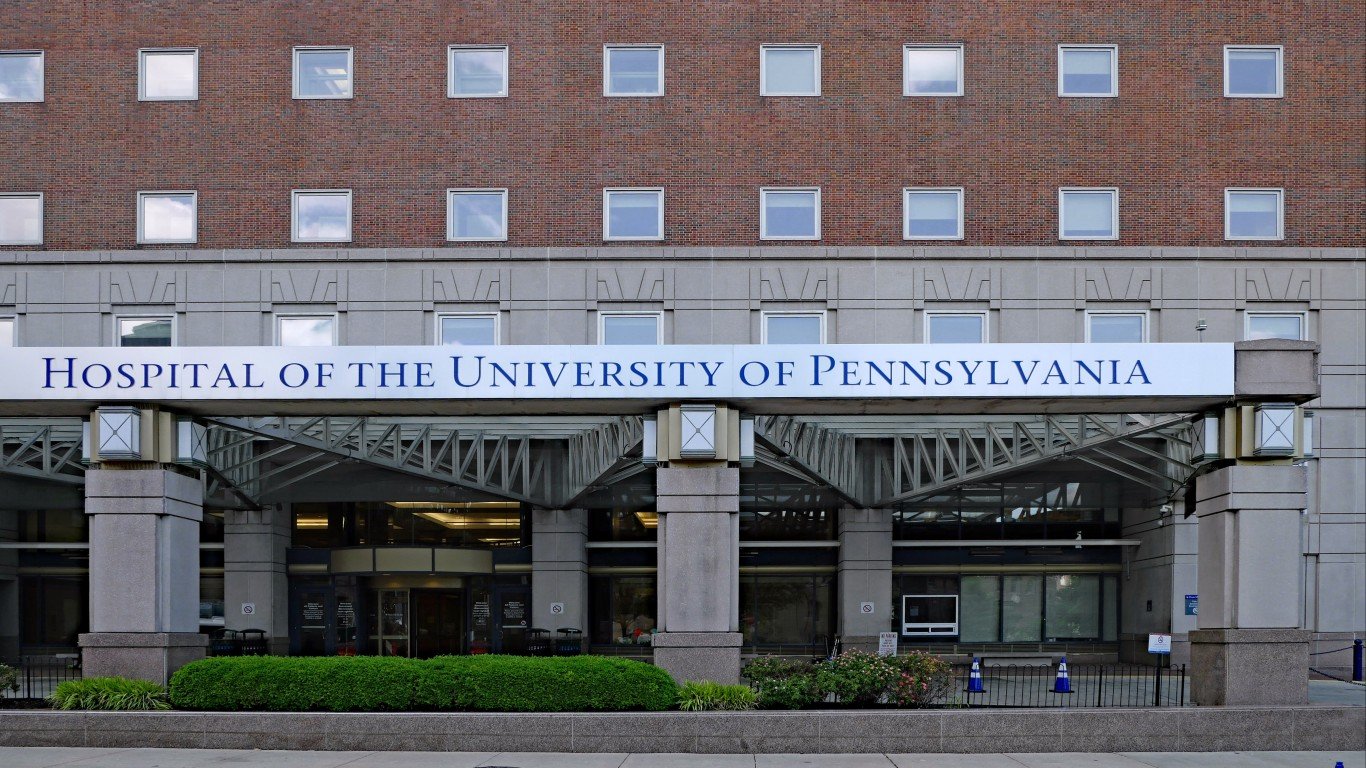
- Acceptance rate: 5.9%
- Student-faculty ratio: 5-to-1
- Graduation rate: 96.2%
Founded by Benjamin Franklin, the University of Pennsylvania, also known as UPenn, ranks number seven overall but ranks number one in business, accounting, and finance. The 10,106 undergrads, who receive 63% financial aid, have four undergraduate schools on campus to choose from.
The average annual net price, including financial aid and scholarships, is $14,578. Median earnings for graduates six years after receiving their degrees is $85,900, with 96.1% employed two years after graduation.
6. Columbia University (New York, NY)
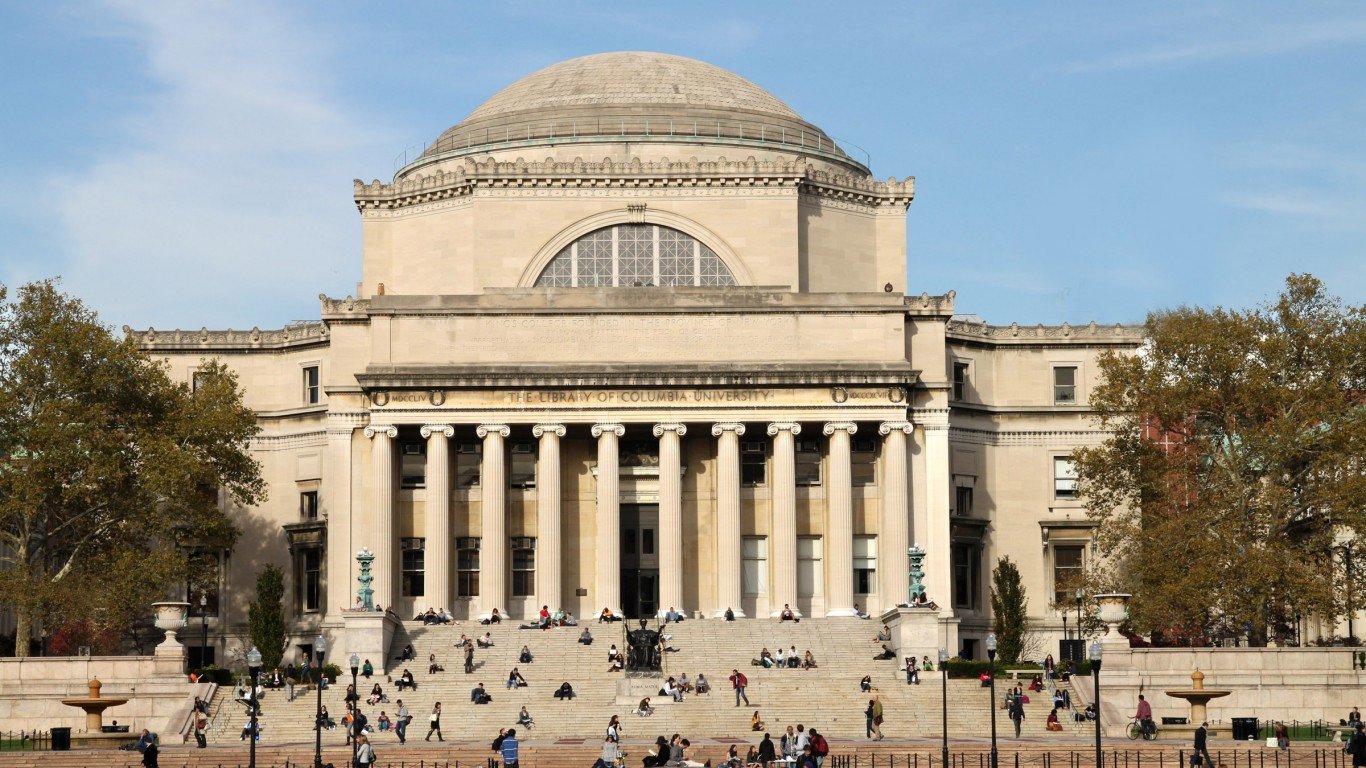
- Acceptance rate: 4.1%
- Student-faculty ratio: 2-to-1
- Graduation rate: 97.4%
Columbia University’s three undergraduate colleges, Columbia Engineering, Columbia College, and General Studies, make up the 8,161 students (57,6% receive financial aid) who have an average annual net tuition price of $12,411, including financial aid and scholarships. The percentage of alumni employed two years after graduation is 93.2%, and their median earnings six years after earning their degree is $83,300.
5. Princeton University (Princeton, NJ)
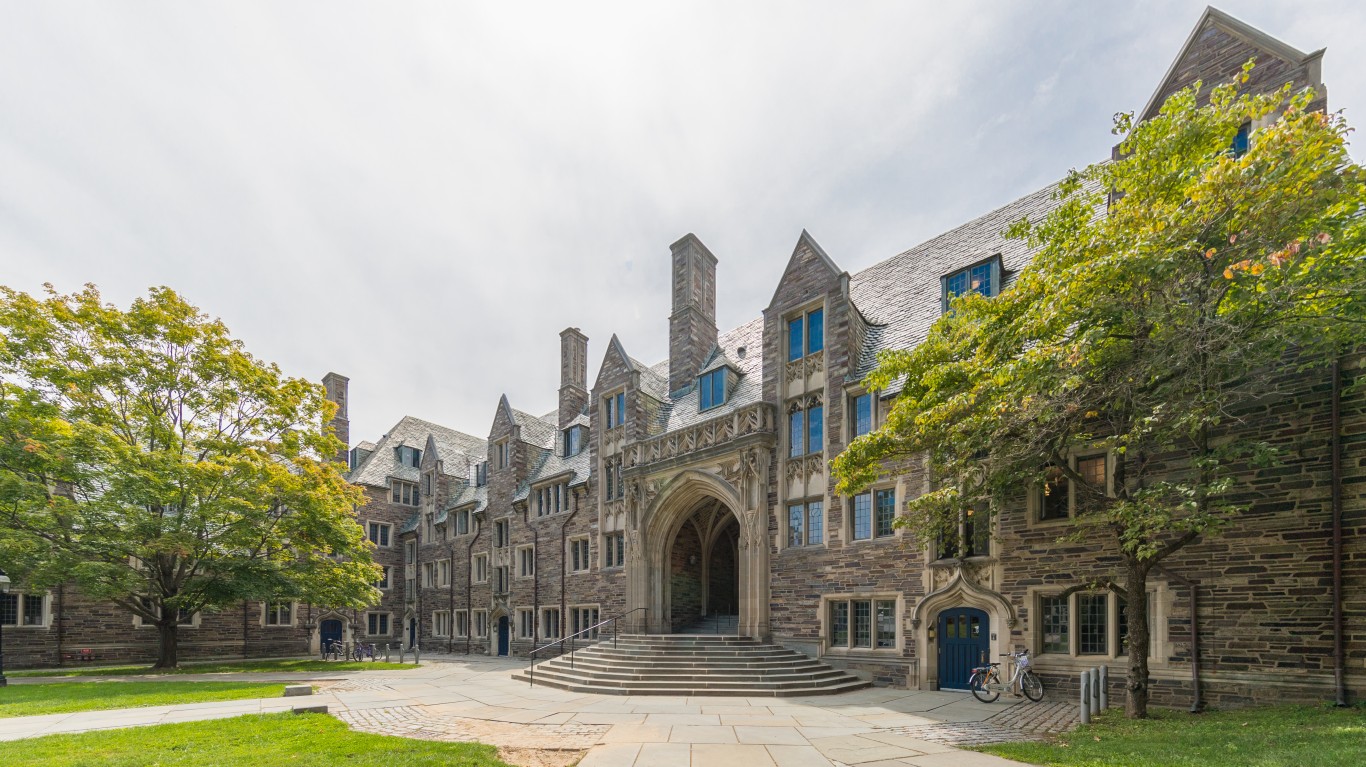
- Acceptance rate: 4.4%
- Student-faculty ratio: 5-to-1
- Graduation rate: 97.6%
Princeton is the fourth-oldest university in the United States and the majority of its 5,590 undergraduates are women (51% to 49% men). the average annual net price, with financial aid and scholarships, is $20,908. For those with family incomes less than $100,000, full tuition, housing, food, books, and personal expenses are covered.
Graduates have a median earnings of $74,700 six years after graduation and 92% of alumni are employed two years after receiving their degrees.
4. Harvard University (Cambridge, MA)
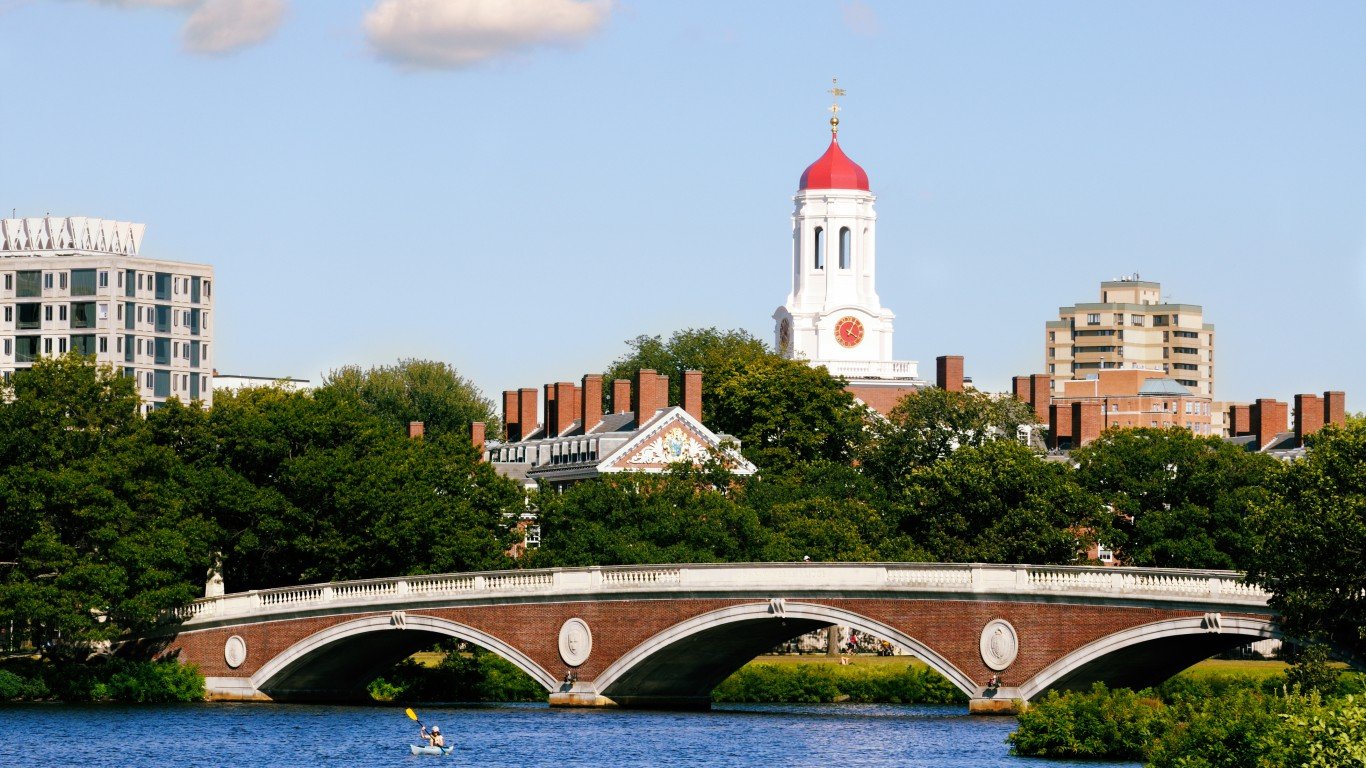
- Acceptance rate: 4.0%
- Student-faculty ratio: 4-to-1
- Graduation rate: 96.7%
The oldest college in America, founded in 1636, Harvard University is now comprised of 14 different schools that allow its undergraduates a variety of degree choices. Of the almost 57,000 applicants for the class of 2027, the university accepted 1,966, bringing its undergrad total to 9,579, of which 73.3% received financial aid. The average annual net price with financial aid and scholarships is $13,910.
Six years after graduation, the median earnings of alumni is $89,900, and 93.9% are employed two years after graduation.
3. Massachusetts Institute of Technology (Cambridge, MA)
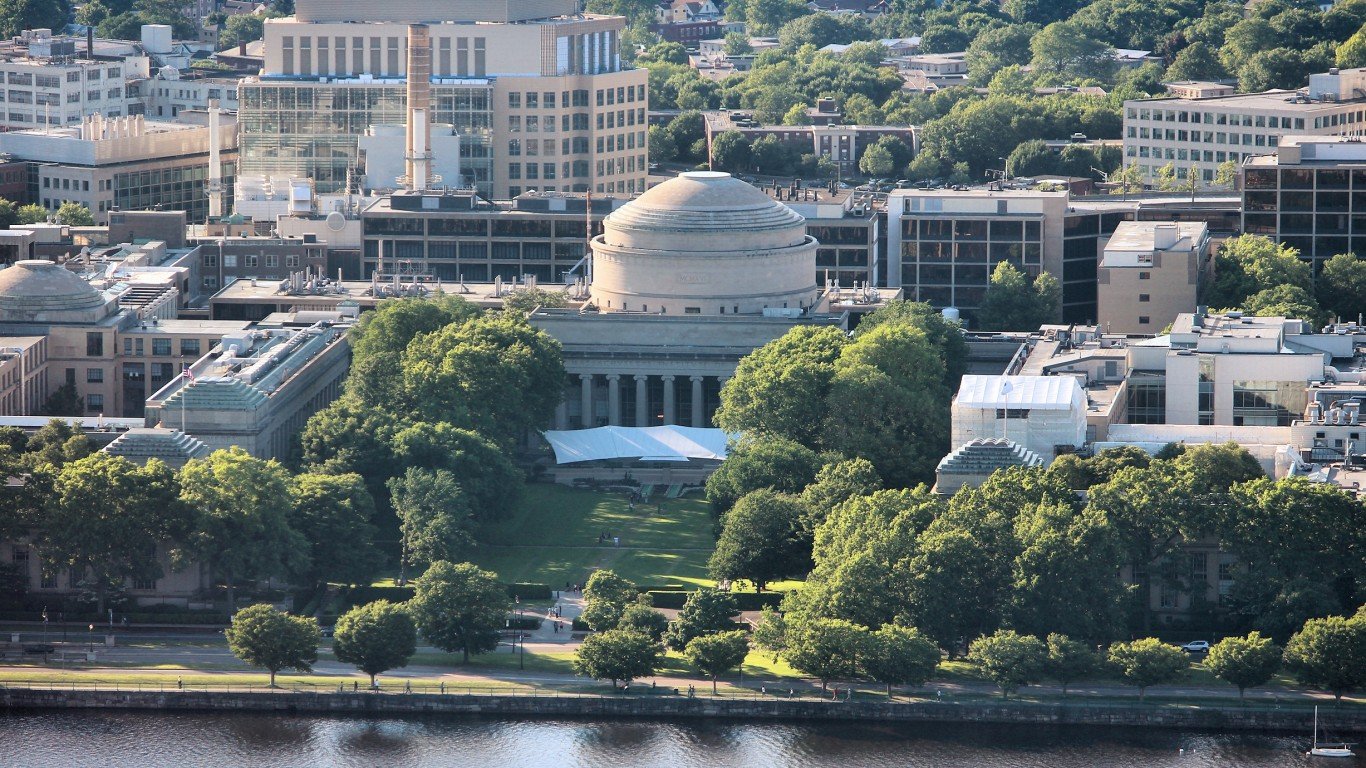
- Acceptance rate: 4.1%
- Student-faculty ratio: 3-to-1
- Graduation rate: 96.2%
According to MIT, the institute is built on the idea that talent and good ideas can come from anywhere. Founded in 1861, MIT currently has 4,756 undergraduate students who pay an average annual net price of $30,958, with financial aid and scholarships. The median earnings a graduate makes is $104,000 and 93.4% of alumni are employed two years after graduating.
2. Stanford University (Stanford, CA)
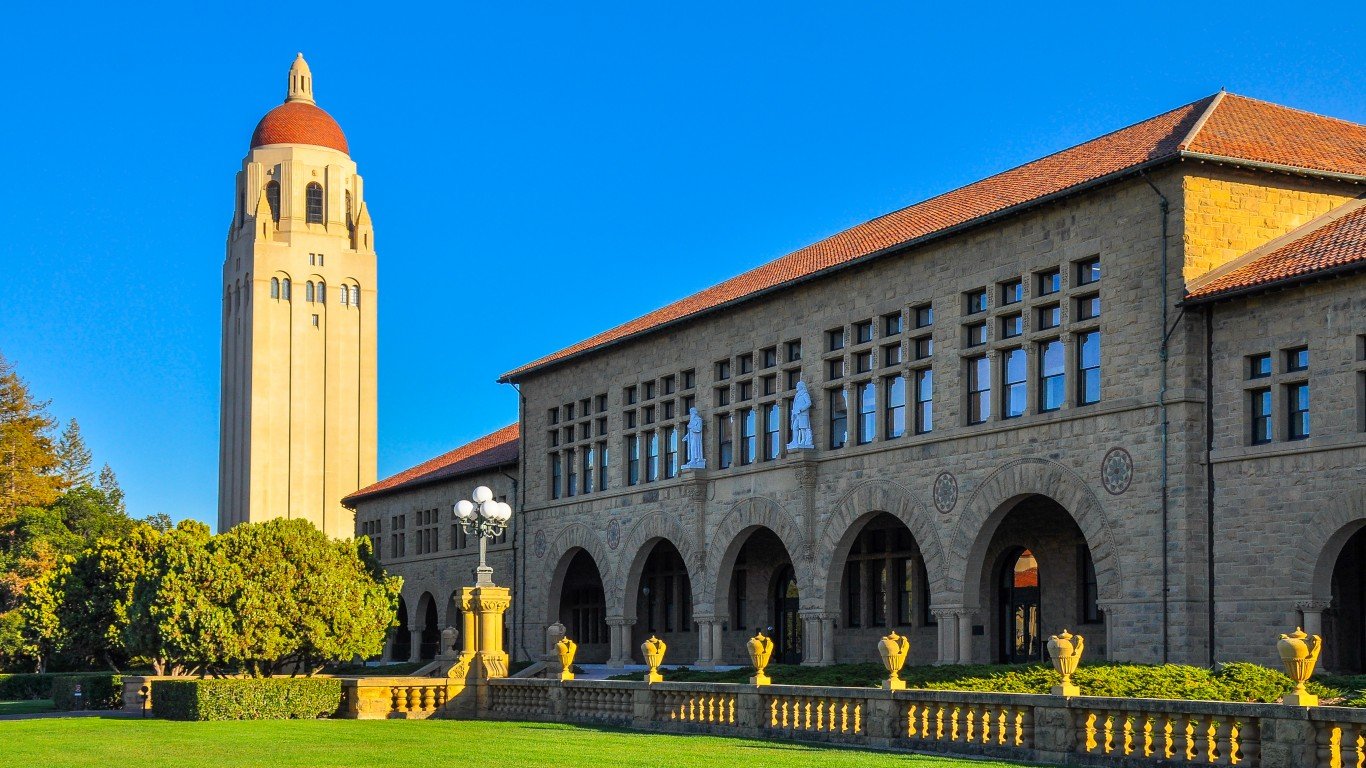
- Acceptance rate: 3.9%
- Student-faculty ratio: 2-to-1
- Graduation rate: 95.5%
Founded almost 150 years ago, Stanford leads the effort in pioneering research that draws students to its campus each year. Undergraduate enrollment is currently at 7,841, which is comprised of around 1,700 freshmen and 30 transfer students. For students with families earning under $150,000, tuition is covered and for those with incomes under $100,000, tuition, room, and board are covered.
The average annual net price is $14,402, with financial aid and scholarships, and the median earnings six years after graduation is $94,000. The percentage of alumni employed two years after graduation is 92.5%.
1. Yale University (New Haven, CT)
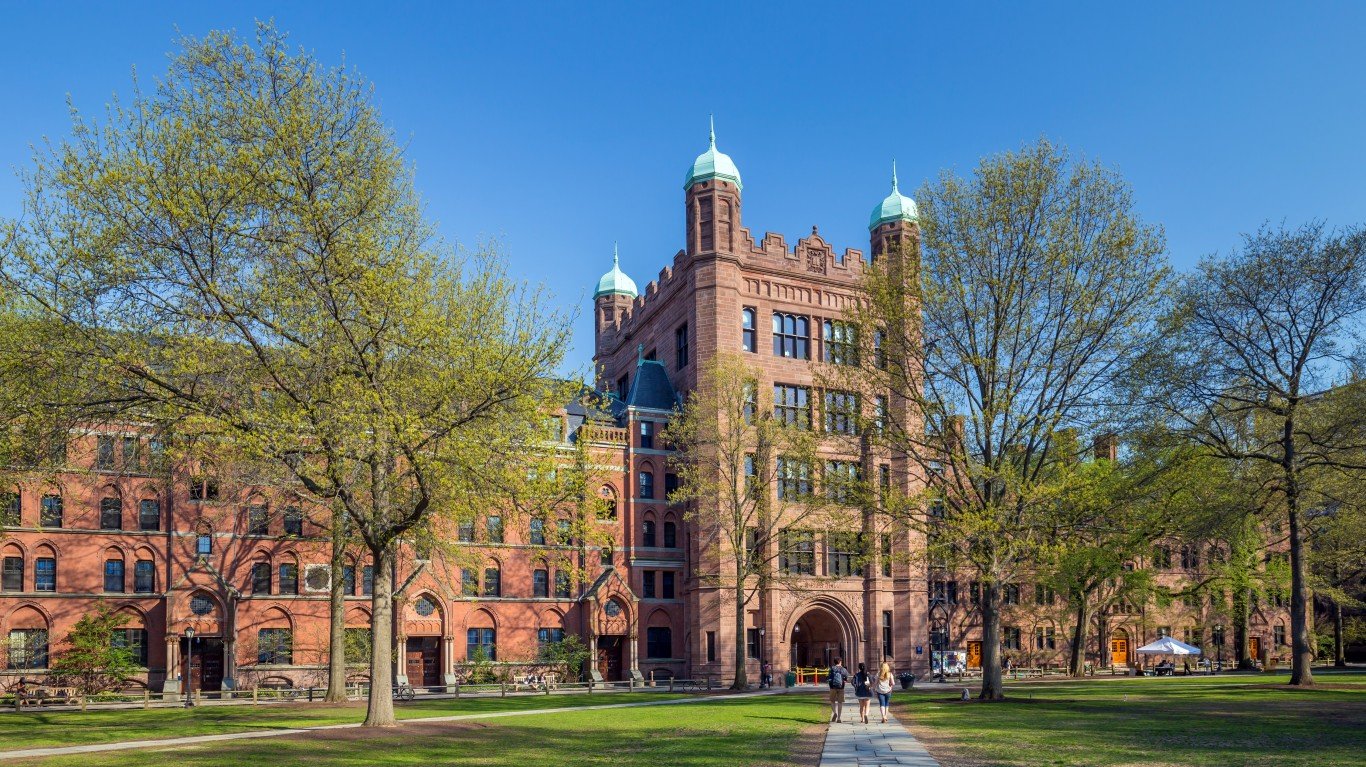
- Acceptance rate: 5.3%
- Student-faculty ratio: 2-to-1
- Graduation rate: 96.9%
This prestigious university has an average annual net price of $20,605 (factoring in financial aid and scholarships) and the undergraduate enrollment is 6,590 students, of which 56% receive financial aid. The median earnings six years after graduation is $83,000 and 94.2% of alumni are employed two years after graduation.
Smart Investors Are Quietly Loading Up on These “Dividend Legends” (Sponsored)
If you want your portfolio to pay you cash like clockwork, it’s time to stop blindly following conventional wisdom like relying on Dividend Aristocrats. There’s a better option, and we want to show you. We’re offering a brand-new report on 2 stocks we believe offer the rare combination of a high dividend yield and significant stock appreciation upside. If you’re tired of feeling one step behind in this market, this free report is a must-read for you.
Click here to download your FREE copy of “2 Dividend Legends to Hold Forever” and start improving your portfolio today.
Thank you for reading! Have some feedback for us?
Contact the 24/7 Wall St. editorial team.
